RBP020L055A Advanced Project Management
VerifiedAdded on 2023/02/13
|22
|8302
|35
AI Summary
Mastering project management is crucial to organizations in the 21st century. This module enables students to learn the 'hard' science essential for project managers today, but with the crucial emphasis on the soft skills involved in managing people and change in order to help achieve delivery of successful projects.
Contribute Materials
Your contribution can guide someone’s learning journey. Share your
documents today.
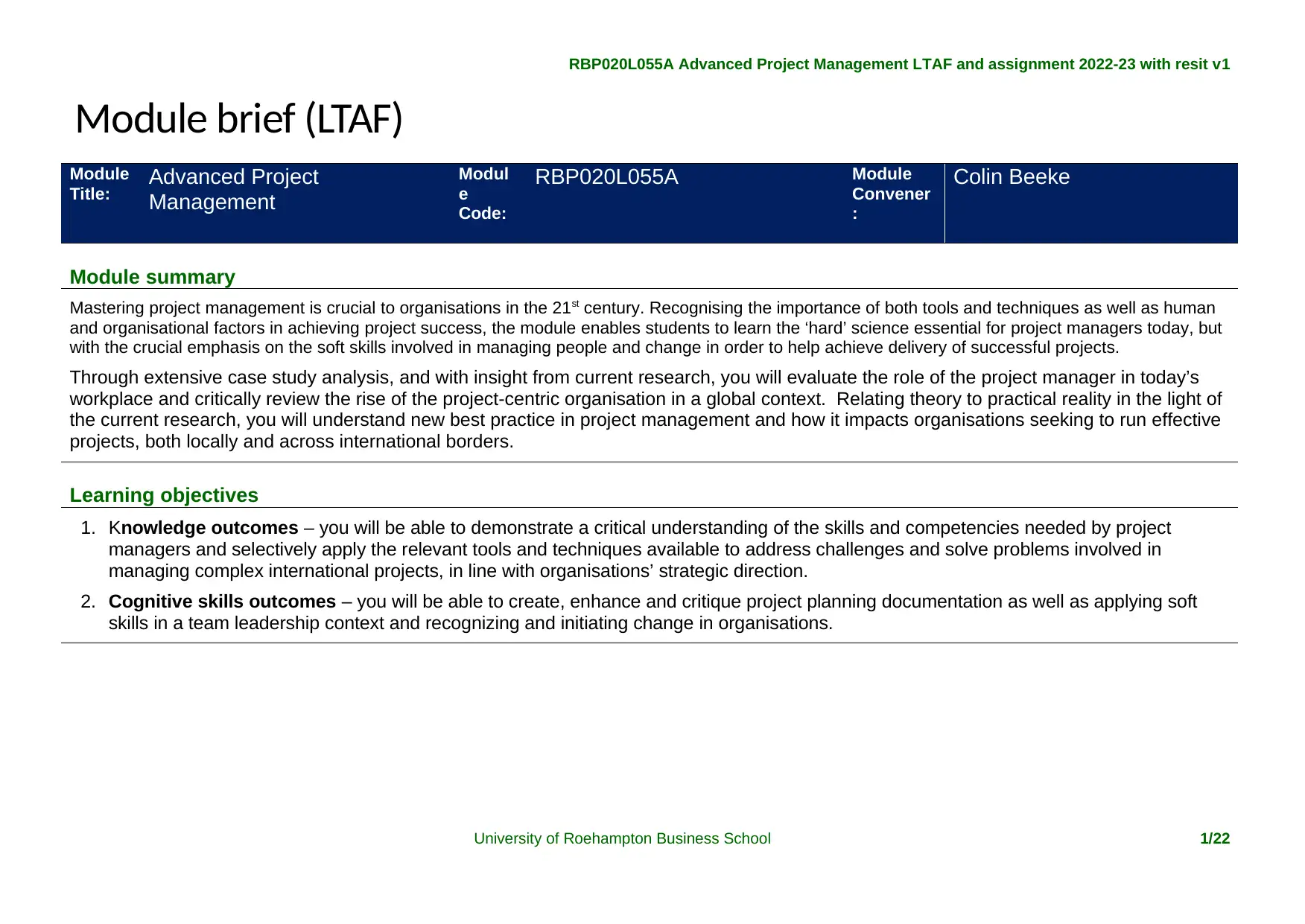
RBP020L055A Advanced Project Management LTAF and assignment 2022-23 with resit v1
Module brief (LTAF)
Module
Title: Advanced Project
Management
Modul
e
Code:
RBP020L055A Module
Convener
:
Colin Beeke
Module summary
Mastering project management is crucial to organisations in the 21st century. Recognising the importance of both tools and techniques as well as human
and organisational factors in achieving project success, the module enables students to learn the ‘hard’ science essential for project managers today, but
with the crucial emphasis on the soft skills involved in managing people and change in order to help achieve delivery of successful projects.
Through extensive case study analysis, and with insight from current research, you will evaluate the role of the project manager in today’s
workplace and critically review the rise of the project-centric organisation in a global context. Relating theory to practical reality in the light of
the current research, you will understand new best practice in project management and how it impacts organisations seeking to run effective
projects, both locally and across international borders.
Learning objectives
1. Knowledge outcomes – you will be able to demonstrate a critical understanding of the skills and competencies needed by project
managers and selectively apply the relevant tools and techniques available to address challenges and solve problems involved in
managing complex international projects, in line with organisations’ strategic direction.
2. Cognitive skills outcomes – you will be able to create, enhance and critique project planning documentation as well as applying soft
skills in a team leadership context and recognizing and initiating change in organisations.
University of Roehampton Business School 1/22
Module brief (LTAF)
Module
Title: Advanced Project
Management
Modul
e
Code:
RBP020L055A Module
Convener
:
Colin Beeke
Module summary
Mastering project management is crucial to organisations in the 21st century. Recognising the importance of both tools and techniques as well as human
and organisational factors in achieving project success, the module enables students to learn the ‘hard’ science essential for project managers today, but
with the crucial emphasis on the soft skills involved in managing people and change in order to help achieve delivery of successful projects.
Through extensive case study analysis, and with insight from current research, you will evaluate the role of the project manager in today’s
workplace and critically review the rise of the project-centric organisation in a global context. Relating theory to practical reality in the light of
the current research, you will understand new best practice in project management and how it impacts organisations seeking to run effective
projects, both locally and across international borders.
Learning objectives
1. Knowledge outcomes – you will be able to demonstrate a critical understanding of the skills and competencies needed by project
managers and selectively apply the relevant tools and techniques available to address challenges and solve problems involved in
managing complex international projects, in line with organisations’ strategic direction.
2. Cognitive skills outcomes – you will be able to create, enhance and critique project planning documentation as well as applying soft
skills in a team leadership context and recognizing and initiating change in organisations.
University of Roehampton Business School 1/22
Secure Best Marks with AI Grader
Need help grading? Try our AI Grader for instant feedback on your assignments.
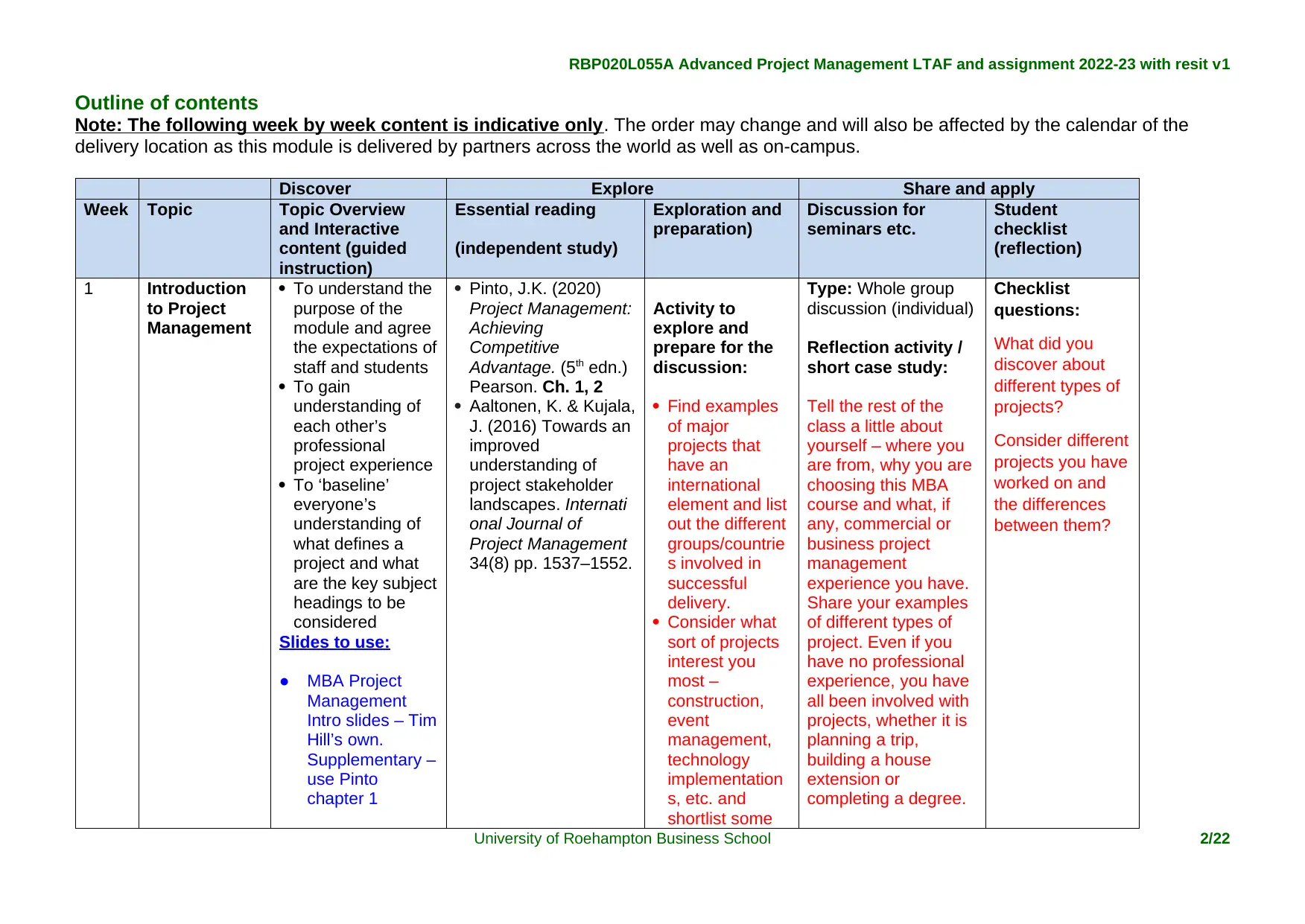
RBP020L055A Advanced Project Management LTAF and assignment 2022-23 with resit v1
Outline of contents
Note: The following week by week content is indicative only. The order may change and will also be affected by the calendar of the
delivery location as this module is delivered by partners across the world as well as on-campus.
Discover Explore Share and apply
Week Topic Topic Overview
and Interactive
content (guided
instruction)
Essential reading
(independent study)
Exploration and
preparation)
Discussion for
seminars etc.
Student
checklist
(reflection)
1 Introduction
to Project
Management
To understand the
purpose of the
module and agree
the expectations of
staff and students
To gain
understanding of
each other’s
professional
project experience
To ‘baseline’
everyone’s
understanding of
what defines a
project and what
are the key subject
headings to be
considered
Slides to use:
● MBA Project
Management
Intro slides – Tim
Hill’s own.
Supplementary –
use Pinto
chapter 1
Pinto, J.K. (2020)
Project Management:
Achieving
Competitive
Advantage. (5th edn.)
Pearson. Ch. 1, 2
Aaltonen, K. & Kujala,
J. (2016) Towards an
improved
understanding of
project stakeholder
landscapes. Internati
onal Journal of
Project Management
34(8) pp. 1537–1552.
Activity to
explore and
prepare for the
discussion:
Find examples
of major
projects that
have an
international
element and list
out the different
groups/countrie
s involved in
successful
delivery.
Consider what
sort of projects
interest you
most –
construction,
event
management,
technology
implementation
s, etc. and
shortlist some
Type: Whole group
discussion (individual)
Reflection activity /
short case study:
Tell the rest of the
class a little about
yourself – where you
are from, why you are
choosing this MBA
course and what, if
any, commercial or
business project
management
experience you have.
Share your examples
of different types of
project. Even if you
have no professional
experience, you have
all been involved with
projects, whether it is
planning a trip,
building a house
extension or
completing a degree.
Checklist
questions:
What did you
discover about
different types of
projects?
Consider different
projects you have
worked on and
the differences
between them?
University of Roehampton Business School 2/22
Outline of contents
Note: The following week by week content is indicative only. The order may change and will also be affected by the calendar of the
delivery location as this module is delivered by partners across the world as well as on-campus.
Discover Explore Share and apply
Week Topic Topic Overview
and Interactive
content (guided
instruction)
Essential reading
(independent study)
Exploration and
preparation)
Discussion for
seminars etc.
Student
checklist
(reflection)
1 Introduction
to Project
Management
To understand the
purpose of the
module and agree
the expectations of
staff and students
To gain
understanding of
each other’s
professional
project experience
To ‘baseline’
everyone’s
understanding of
what defines a
project and what
are the key subject
headings to be
considered
Slides to use:
● MBA Project
Management
Intro slides – Tim
Hill’s own.
Supplementary –
use Pinto
chapter 1
Pinto, J.K. (2020)
Project Management:
Achieving
Competitive
Advantage. (5th edn.)
Pearson. Ch. 1, 2
Aaltonen, K. & Kujala,
J. (2016) Towards an
improved
understanding of
project stakeholder
landscapes. Internati
onal Journal of
Project Management
34(8) pp. 1537–1552.
Activity to
explore and
prepare for the
discussion:
Find examples
of major
projects that
have an
international
element and list
out the different
groups/countrie
s involved in
successful
delivery.
Consider what
sort of projects
interest you
most –
construction,
event
management,
technology
implementation
s, etc. and
shortlist some
Type: Whole group
discussion (individual)
Reflection activity /
short case study:
Tell the rest of the
class a little about
yourself – where you
are from, why you are
choosing this MBA
course and what, if
any, commercial or
business project
management
experience you have.
Share your examples
of different types of
project. Even if you
have no professional
experience, you have
all been involved with
projects, whether it is
planning a trip,
building a house
extension or
completing a degree.
Checklist
questions:
What did you
discover about
different types of
projects?
Consider different
projects you have
worked on and
the differences
between them?
University of Roehampton Business School 2/22
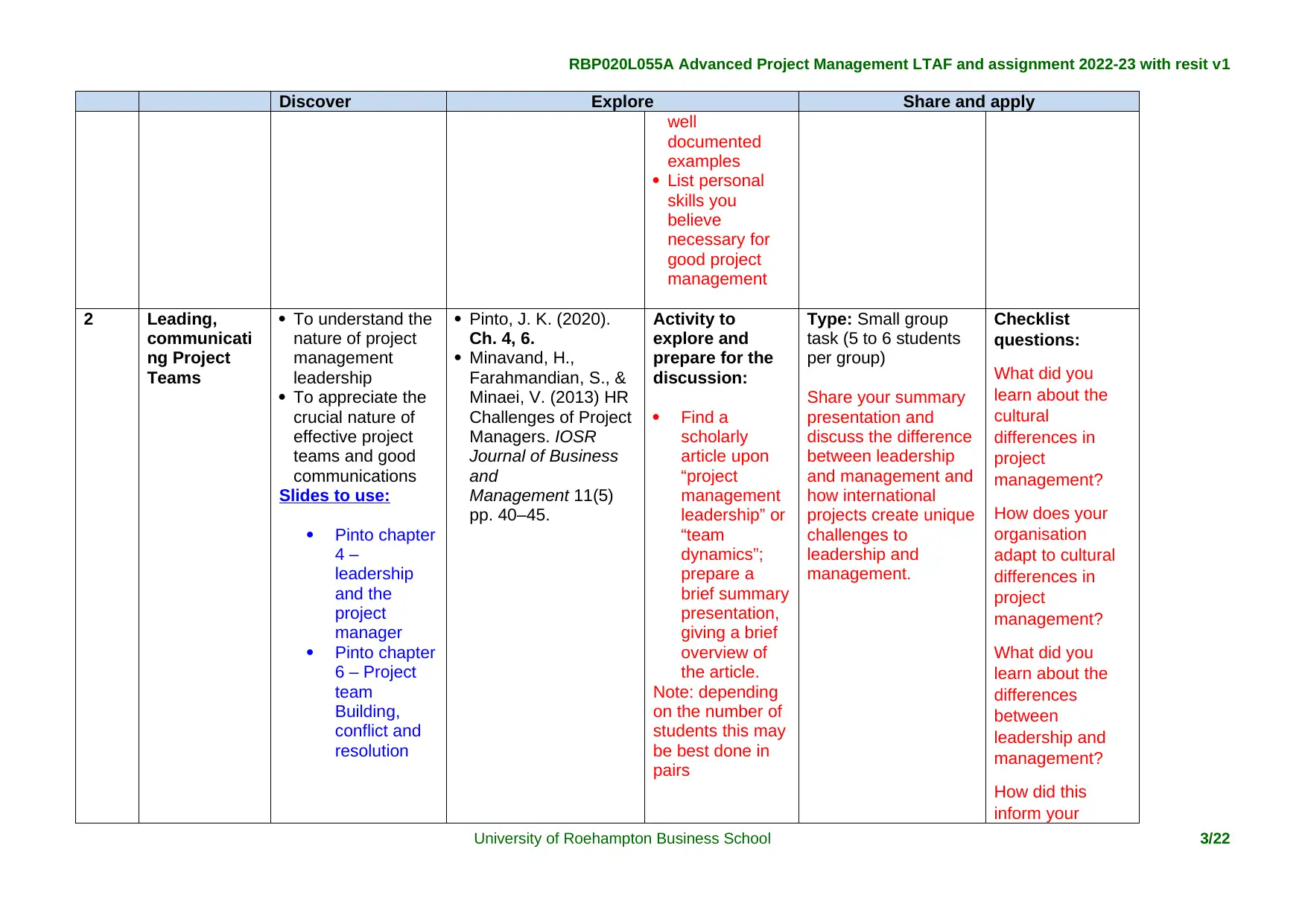
RBP020L055A Advanced Project Management LTAF and assignment 2022-23 with resit v1
Discover Explore Share and apply
well
documented
examples
List personal
skills you
believe
necessary for
good project
management
2 Leading,
communicati
ng Project
Teams
To understand the
nature of project
management
leadership
To appreciate the
crucial nature of
effective project
teams and good
communications
Slides to use:
Pinto chapter
4 –
leadership
and the
project
manager
Pinto chapter
6 – Project
team
Building,
conflict and
resolution
Pinto, J. K. (2020).
Ch. 4, 6.
Minavand, H.,
Farahmandian, S., &
Minaei, V. (2013) HR
Challenges of Project
Managers. IOSR
Journal of Business
and
Management 11(5)
pp. 40–45.
Activity to
explore and
prepare for the
discussion:
Find a
scholarly
article upon
“project
management
leadership” or
“team
dynamics”;
prepare a
brief summary
presentation,
giving a brief
overview of
the article.
Note: depending
on the number of
students this may
be best done in
pairs
Type: Small group
task (5 to 6 students
per group)
Share your summary
presentation and
discuss the difference
between leadership
and management and
how international
projects create unique
challenges to
leadership and
management.
Checklist
questions:
What did you
learn about the
cultural
differences in
project
management?
How does your
organisation
adapt to cultural
differences in
project
management?
What did you
learn about the
differences
between
leadership and
management?
How did this
inform your
University of Roehampton Business School 3/22
Discover Explore Share and apply
well
documented
examples
List personal
skills you
believe
necessary for
good project
management
2 Leading,
communicati
ng Project
Teams
To understand the
nature of project
management
leadership
To appreciate the
crucial nature of
effective project
teams and good
communications
Slides to use:
Pinto chapter
4 –
leadership
and the
project
manager
Pinto chapter
6 – Project
team
Building,
conflict and
resolution
Pinto, J. K. (2020).
Ch. 4, 6.
Minavand, H.,
Farahmandian, S., &
Minaei, V. (2013) HR
Challenges of Project
Managers. IOSR
Journal of Business
and
Management 11(5)
pp. 40–45.
Activity to
explore and
prepare for the
discussion:
Find a
scholarly
article upon
“project
management
leadership” or
“team
dynamics”;
prepare a
brief summary
presentation,
giving a brief
overview of
the article.
Note: depending
on the number of
students this may
be best done in
pairs
Type: Small group
task (5 to 6 students
per group)
Share your summary
presentation and
discuss the difference
between leadership
and management and
how international
projects create unique
challenges to
leadership and
management.
Checklist
questions:
What did you
learn about the
cultural
differences in
project
management?
How does your
organisation
adapt to cultural
differences in
project
management?
What did you
learn about the
differences
between
leadership and
management?
How did this
inform your
University of Roehampton Business School 3/22
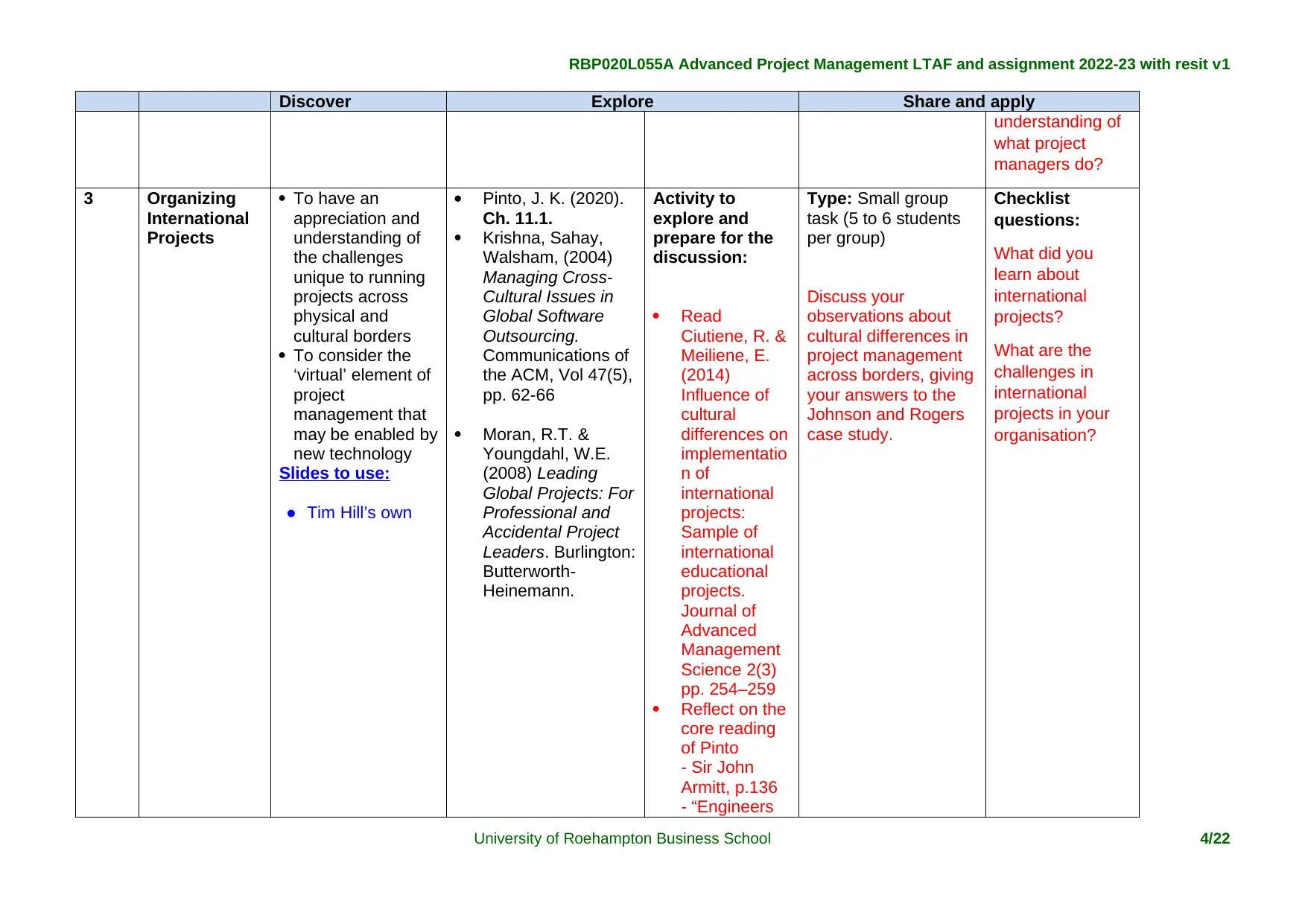
RBP020L055A Advanced Project Management LTAF and assignment 2022-23 with resit v1
Discover Explore Share and apply
understanding of
what project
managers do?
3 Organizing
International
Projects
To have an
appreciation and
understanding of
the challenges
unique to running
projects across
physical and
cultural borders
To consider the
‘virtual’ element of
project
management that
may be enabled by
new technology
Slides to use:
● Tim Hill’s own
Pinto, J. K. (2020).
Ch. 11.1.
Krishna, Sahay,
Walsham, (2004)
Managing Cross-
Cultural Issues in
Global Software
Outsourcing.
Communications of
the ACM, Vol 47(5),
pp. 62-66
Moran, R.T. &
Youngdahl, W.E.
(2008) Leading
Global Projects: For
Professional and
Accidental Project
Leaders. Burlington:
Butterworth-
Heinemann.
Activity to
explore and
prepare for the
discussion:
Read
Ciutiene, R. &
Meiliene, E.
(2014)
Influence of
cultural
differences on
implementatio
n of
international
projects:
Sample of
international
educational
projects.
Journal of
Advanced
Management
Science 2(3)
pp. 254–259
Reflect on the
core reading
of Pinto
- Sir John
Armitt, p.136
- “Engineers
Type: Small group
task (5 to 6 students
per group)
Discuss your
observations about
cultural differences in
project management
across borders, giving
your answers to the
Johnson and Rogers
case study.
Checklist
questions:
What did you
learn about
international
projects?
What are the
challenges in
international
projects in your
organisation?
University of Roehampton Business School 4/22
Discover Explore Share and apply
understanding of
what project
managers do?
3 Organizing
International
Projects
To have an
appreciation and
understanding of
the challenges
unique to running
projects across
physical and
cultural borders
To consider the
‘virtual’ element of
project
management that
may be enabled by
new technology
Slides to use:
● Tim Hill’s own
Pinto, J. K. (2020).
Ch. 11.1.
Krishna, Sahay,
Walsham, (2004)
Managing Cross-
Cultural Issues in
Global Software
Outsourcing.
Communications of
the ACM, Vol 47(5),
pp. 62-66
Moran, R.T. &
Youngdahl, W.E.
(2008) Leading
Global Projects: For
Professional and
Accidental Project
Leaders. Burlington:
Butterworth-
Heinemann.
Activity to
explore and
prepare for the
discussion:
Read
Ciutiene, R. &
Meiliene, E.
(2014)
Influence of
cultural
differences on
implementatio
n of
international
projects:
Sample of
international
educational
projects.
Journal of
Advanced
Management
Science 2(3)
pp. 254–259
Reflect on the
core reading
of Pinto
- Sir John
Armitt, p.136
- “Engineers
Type: Small group
task (5 to 6 students
per group)
Discuss your
observations about
cultural differences in
project management
across borders, giving
your answers to the
Johnson and Rogers
case study.
Checklist
questions:
What did you
learn about
international
projects?
What are the
challenges in
international
projects in your
organisation?
University of Roehampton Business School 4/22
Secure Best Marks with AI Grader
Need help grading? Try our AI Grader for instant feedback on your assignments.
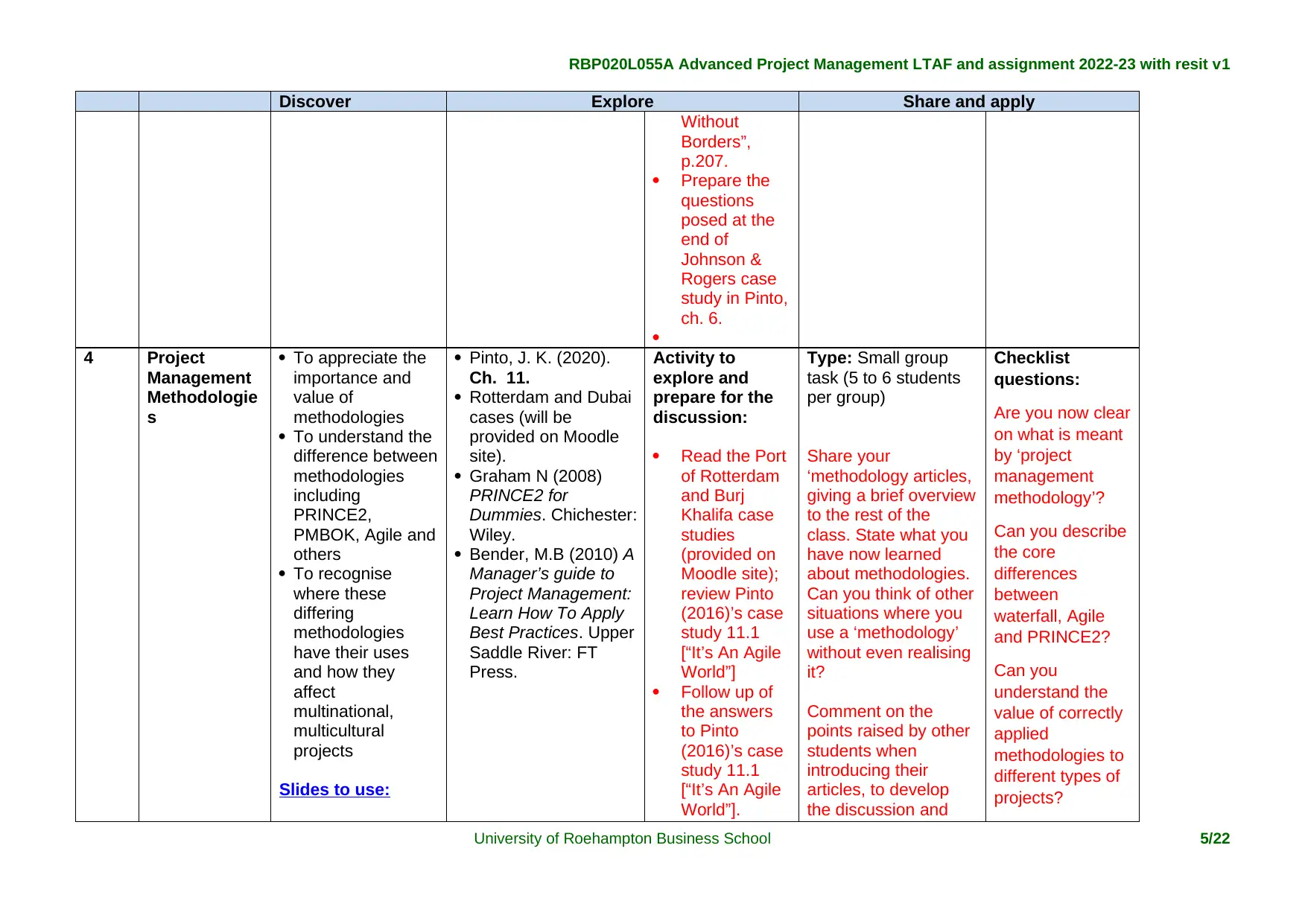
RBP020L055A Advanced Project Management LTAF and assignment 2022-23 with resit v1
Discover Explore Share and apply
Without
Borders”,
p.207.
Prepare the
questions
posed at the
end of
Johnson &
Rogers case
study in Pinto,
ch. 6.
4 Project
Management
Methodologie
s
To appreciate the
importance and
value of
methodologies
To understand the
difference between
methodologies
including
PRINCE2,
PMBOK, Agile and
others
To recognise
where these
differing
methodologies
have their uses
and how they
affect
multinational,
multicultural
projects
Slides to use:
Pinto, J. K. (2020).
Ch. 11.
Rotterdam and Dubai
cases (will be
provided on Moodle
site).
Graham N (2008)
PRINCE2 for
Dummies. Chichester:
Wiley.
Bender, M.B (2010) A
Manager’s guide to
Project Management:
Learn How To Apply
Best Practices. Upper
Saddle River: FT
Press.
Activity to
explore and
prepare for the
discussion:
Read the Port
of Rotterdam
and Burj
Khalifa case
studies
(provided on
Moodle site);
review Pinto
(2016)’s case
study 11.1
[“It’s An Agile
World”]
Follow up of
the answers
to Pinto
(2016)’s case
study 11.1
[“It’s An Agile
World”].
Type: Small group
task (5 to 6 students
per group)
Share your
‘methodology articles,
giving a brief overview
to the rest of the
class. State what you
have now learned
about methodologies.
Can you think of other
situations where you
use a ‘methodology’
without even realising
it?
Comment on the
points raised by other
students when
introducing their
articles, to develop
the discussion and
Checklist
questions:
Are you now clear
on what is meant
by ‘project
management
methodology’?
Can you describe
the core
differences
between
waterfall, Agile
and PRINCE2?
Can you
understand the
value of correctly
applied
methodologies to
different types of
projects?
University of Roehampton Business School 5/22
Discover Explore Share and apply
Without
Borders”,
p.207.
Prepare the
questions
posed at the
end of
Johnson &
Rogers case
study in Pinto,
ch. 6.
4 Project
Management
Methodologie
s
To appreciate the
importance and
value of
methodologies
To understand the
difference between
methodologies
including
PRINCE2,
PMBOK, Agile and
others
To recognise
where these
differing
methodologies
have their uses
and how they
affect
multinational,
multicultural
projects
Slides to use:
Pinto, J. K. (2020).
Ch. 11.
Rotterdam and Dubai
cases (will be
provided on Moodle
site).
Graham N (2008)
PRINCE2 for
Dummies. Chichester:
Wiley.
Bender, M.B (2010) A
Manager’s guide to
Project Management:
Learn How To Apply
Best Practices. Upper
Saddle River: FT
Press.
Activity to
explore and
prepare for the
discussion:
Read the Port
of Rotterdam
and Burj
Khalifa case
studies
(provided on
Moodle site);
review Pinto
(2016)’s case
study 11.1
[“It’s An Agile
World”]
Follow up of
the answers
to Pinto
(2016)’s case
study 11.1
[“It’s An Agile
World”].
Type: Small group
task (5 to 6 students
per group)
Share your
‘methodology articles,
giving a brief overview
to the rest of the
class. State what you
have now learned
about methodologies.
Can you think of other
situations where you
use a ‘methodology’
without even realising
it?
Comment on the
points raised by other
students when
introducing their
articles, to develop
the discussion and
Checklist
questions:
Are you now clear
on what is meant
by ‘project
management
methodology’?
Can you describe
the core
differences
between
waterfall, Agile
and PRINCE2?
Can you
understand the
value of correctly
applied
methodologies to
different types of
projects?
University of Roehampton Business School 5/22
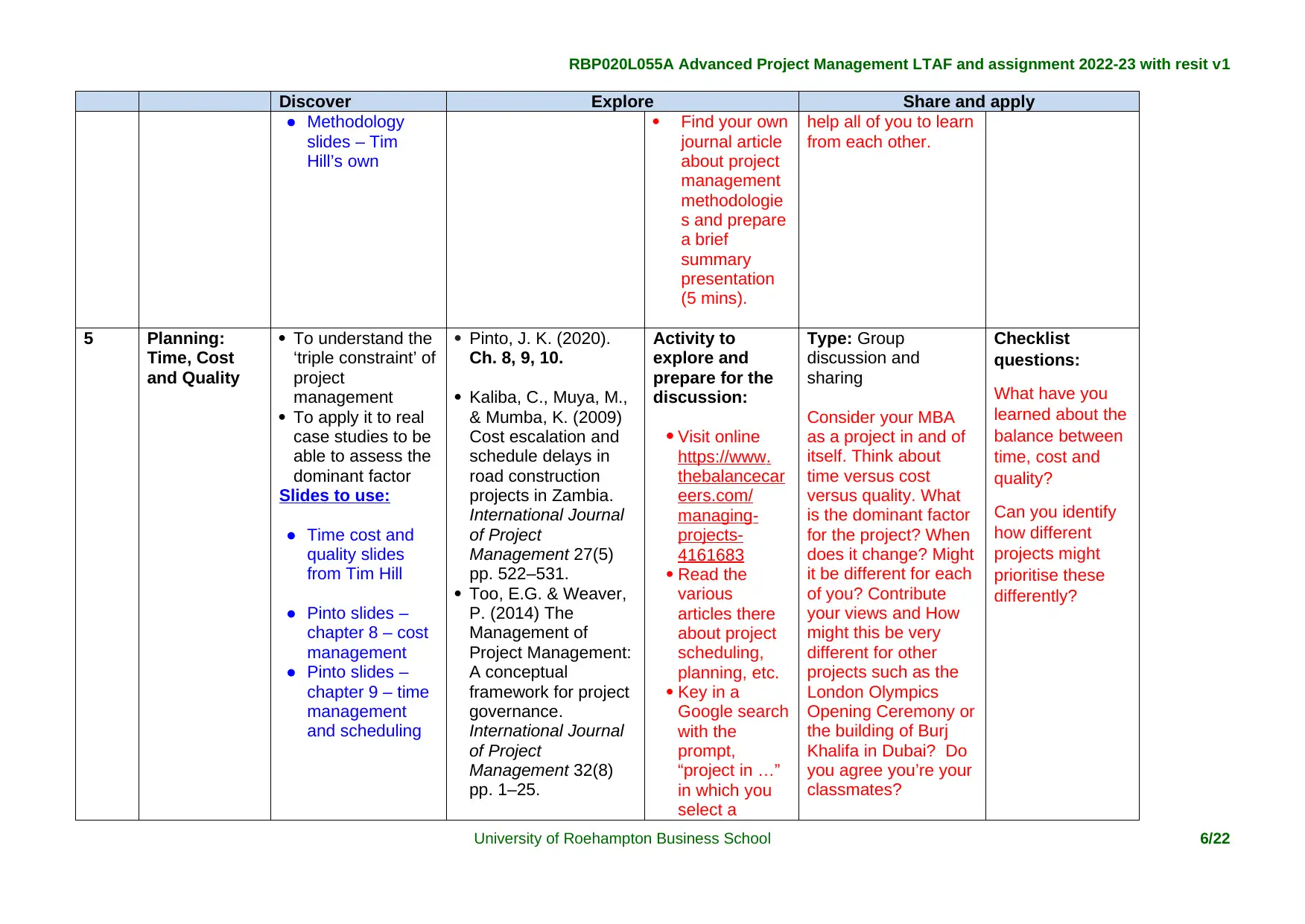
RBP020L055A Advanced Project Management LTAF and assignment 2022-23 with resit v1
Discover Explore Share and apply
● Methodology
slides – Tim
Hill’s own
Find your own
journal article
about project
management
methodologie
s and prepare
a brief
summary
presentation
(5 mins).
help all of you to learn
from each other.
5 Planning:
Time, Cost
and Quality
To understand the
‘triple constraint’ of
project
management
To apply it to real
case studies to be
able to assess the
dominant factor
Slides to use:
● Time cost and
quality slides
from Tim Hill
● Pinto slides –
chapter 8 – cost
management
● Pinto slides –
chapter 9 – time
management
and scheduling
Pinto, J. K. (2020).
Ch. 8, 9, 10.
Kaliba, C., Muya, M.,
& Mumba, K. (2009)
Cost escalation and
schedule delays in
road construction
projects in Zambia.
International Journal
of Project
Management 27(5)
pp. 522–531.
Too, E.G. & Weaver,
P. (2014) The
Management of
Project Management:
A conceptual
framework for project
governance.
International Journal
of Project
Management 32(8)
pp. 1–25.
Activity to
explore and
prepare for the
discussion:
Visit online
https://www.
thebalancecar
eers.com/
managing-
projects-
4161683
Read the
various
articles there
about project
scheduling,
planning, etc.
Key in a
Google search
with the
prompt,
“project in …”
in which you
select a
Type: Group
discussion and
sharing
Consider your MBA
as a project in and of
itself. Think about
time versus cost
versus quality. What
is the dominant factor
for the project? When
does it change? Might
it be different for each
of you? Contribute
your views and How
might this be very
different for other
projects such as the
London Olympics
Opening Ceremony or
the building of Burj
Khalifa in Dubai? Do
you agree you’re your
classmates?
Checklist
questions:
What have you
learned about the
balance between
time, cost and
quality?
Can you identify
how different
projects might
prioritise these
differently?
University of Roehampton Business School 6/22
Discover Explore Share and apply
● Methodology
slides – Tim
Hill’s own
Find your own
journal article
about project
management
methodologie
s and prepare
a brief
summary
presentation
(5 mins).
help all of you to learn
from each other.
5 Planning:
Time, Cost
and Quality
To understand the
‘triple constraint’ of
project
management
To apply it to real
case studies to be
able to assess the
dominant factor
Slides to use:
● Time cost and
quality slides
from Tim Hill
● Pinto slides –
chapter 8 – cost
management
● Pinto slides –
chapter 9 – time
management
and scheduling
Pinto, J. K. (2020).
Ch. 8, 9, 10.
Kaliba, C., Muya, M.,
& Mumba, K. (2009)
Cost escalation and
schedule delays in
road construction
projects in Zambia.
International Journal
of Project
Management 27(5)
pp. 522–531.
Too, E.G. & Weaver,
P. (2014) The
Management of
Project Management:
A conceptual
framework for project
governance.
International Journal
of Project
Management 32(8)
pp. 1–25.
Activity to
explore and
prepare for the
discussion:
Visit online
https://www.
thebalancecar
eers.com/
managing-
projects-
4161683
Read the
various
articles there
about project
scheduling,
planning, etc.
Key in a
Google search
with the
prompt,
“project in …”
in which you
select a
Type: Group
discussion and
sharing
Consider your MBA
as a project in and of
itself. Think about
time versus cost
versus quality. What
is the dominant factor
for the project? When
does it change? Might
it be different for each
of you? Contribute
your views and How
might this be very
different for other
projects such as the
London Olympics
Opening Ceremony or
the building of Burj
Khalifa in Dubai? Do
you agree you’re your
classmates?
Checklist
questions:
What have you
learned about the
balance between
time, cost and
quality?
Can you identify
how different
projects might
prioritise these
differently?
University of Roehampton Business School 6/22
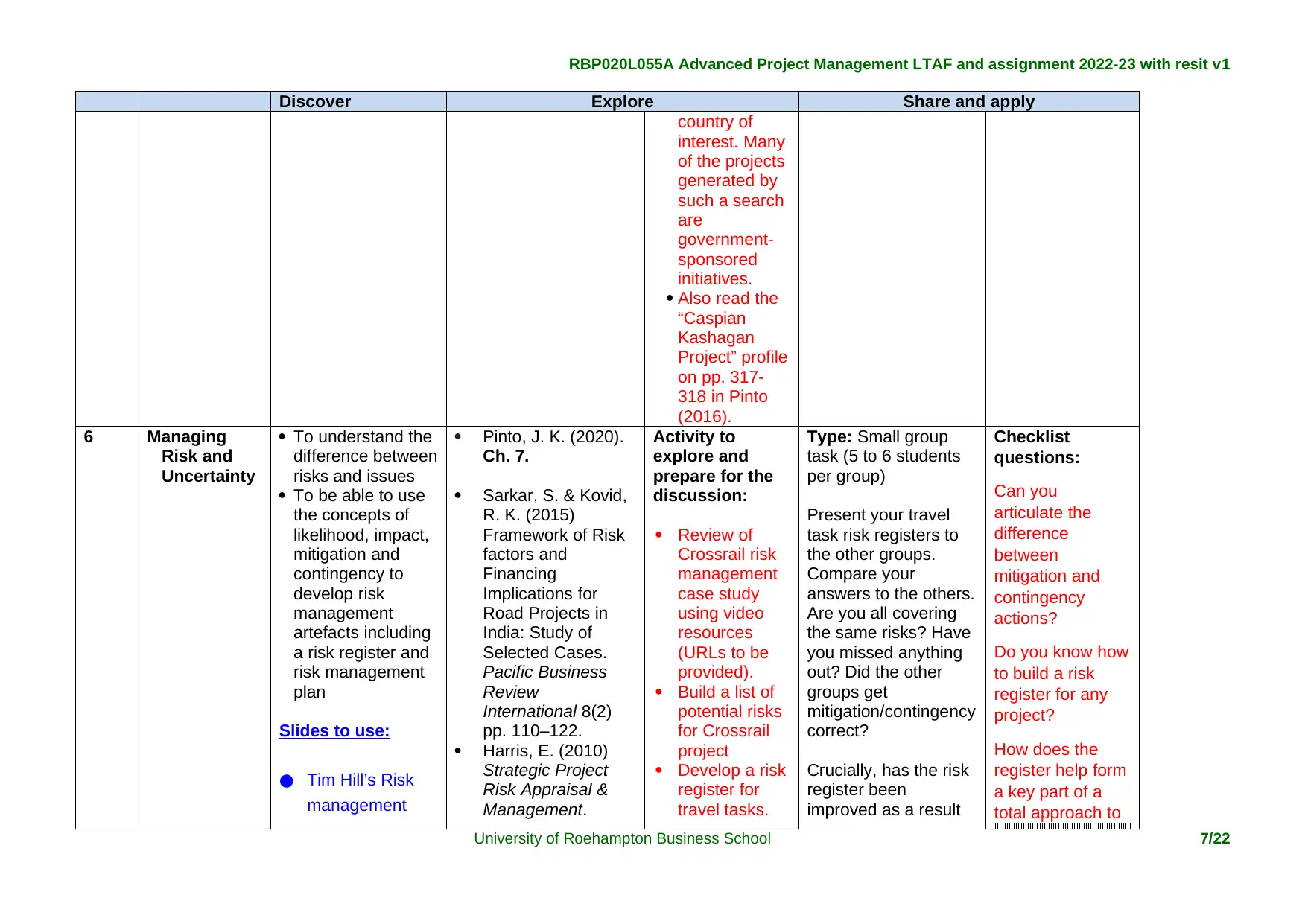
RBP020L055A Advanced Project Management LTAF and assignment 2022-23 with resit v1
Discover Explore Share and apply
country of
interest. Many
of the projects
generated by
such a search
are
government-
sponsored
initiatives.
Also read the
“Caspian
Kashagan
Project” profile
on pp. 317-
318 in Pinto
(2016).
6 Managing
Risk and
Uncertainty
To understand the
difference between
risks and issues
To be able to use
the concepts of
likelihood, impact,
mitigation and
contingency to
develop risk
management
artefacts including
a risk register and
risk management
plan
Slides to use:
● Tim Hill’s Risk
management
Pinto, J. K. (2020).
Ch. 7.
Sarkar, S. & Kovid,
R. K. (2015)
Framework of Risk
factors and
Financing
Implications for
Road Projects in
India: Study of
Selected Cases.
Pacific Business
Review
International 8(2)
pp. 110–122.
Harris, E. (2010)
Strategic Project
Risk Appraisal &
Management.
Activity to
explore and
prepare for the
discussion:
Review of
Crossrail risk
management
case study
using video
resources
(URLs to be
provided).
Build a list of
potential risks
for Crossrail
project
Develop a risk
register for
travel tasks.
Type: Small group
task (5 to 6 students
per group)
Present your travel
task risk registers to
the other groups.
Compare your
answers to the others.
Are you all covering
the same risks? Have
you missed anything
out? Did the other
groups get
mitigation/contingency
correct?
Crucially, has the risk
register been
improved as a result
Checklist
questions:
Can you
articulate the
difference
between
mitigation and
contingency
actions?
Do you know how
to build a risk
register for any
project?
How does the
register help form
a key part of a
total approach to
University of Roehampton Business School 7/22
Discover Explore Share and apply
country of
interest. Many
of the projects
generated by
such a search
are
government-
sponsored
initiatives.
Also read the
“Caspian
Kashagan
Project” profile
on pp. 317-
318 in Pinto
(2016).
6 Managing
Risk and
Uncertainty
To understand the
difference between
risks and issues
To be able to use
the concepts of
likelihood, impact,
mitigation and
contingency to
develop risk
management
artefacts including
a risk register and
risk management
plan
Slides to use:
● Tim Hill’s Risk
management
Pinto, J. K. (2020).
Ch. 7.
Sarkar, S. & Kovid,
R. K. (2015)
Framework of Risk
factors and
Financing
Implications for
Road Projects in
India: Study of
Selected Cases.
Pacific Business
Review
International 8(2)
pp. 110–122.
Harris, E. (2010)
Strategic Project
Risk Appraisal &
Management.
Activity to
explore and
prepare for the
discussion:
Review of
Crossrail risk
management
case study
using video
resources
(URLs to be
provided).
Build a list of
potential risks
for Crossrail
project
Develop a risk
register for
travel tasks.
Type: Small group
task (5 to 6 students
per group)
Present your travel
task risk registers to
the other groups.
Compare your
answers to the others.
Are you all covering
the same risks? Have
you missed anything
out? Did the other
groups get
mitigation/contingency
correct?
Crucially, has the risk
register been
improved as a result
Checklist
questions:
Can you
articulate the
difference
between
mitigation and
contingency
actions?
Do you know how
to build a risk
register for any
project?
How does the
register help form
a key part of a
total approach to
University of Roehampton Business School 7/22
Paraphrase This Document
Need a fresh take? Get an instant paraphrase of this document with our AI Paraphraser
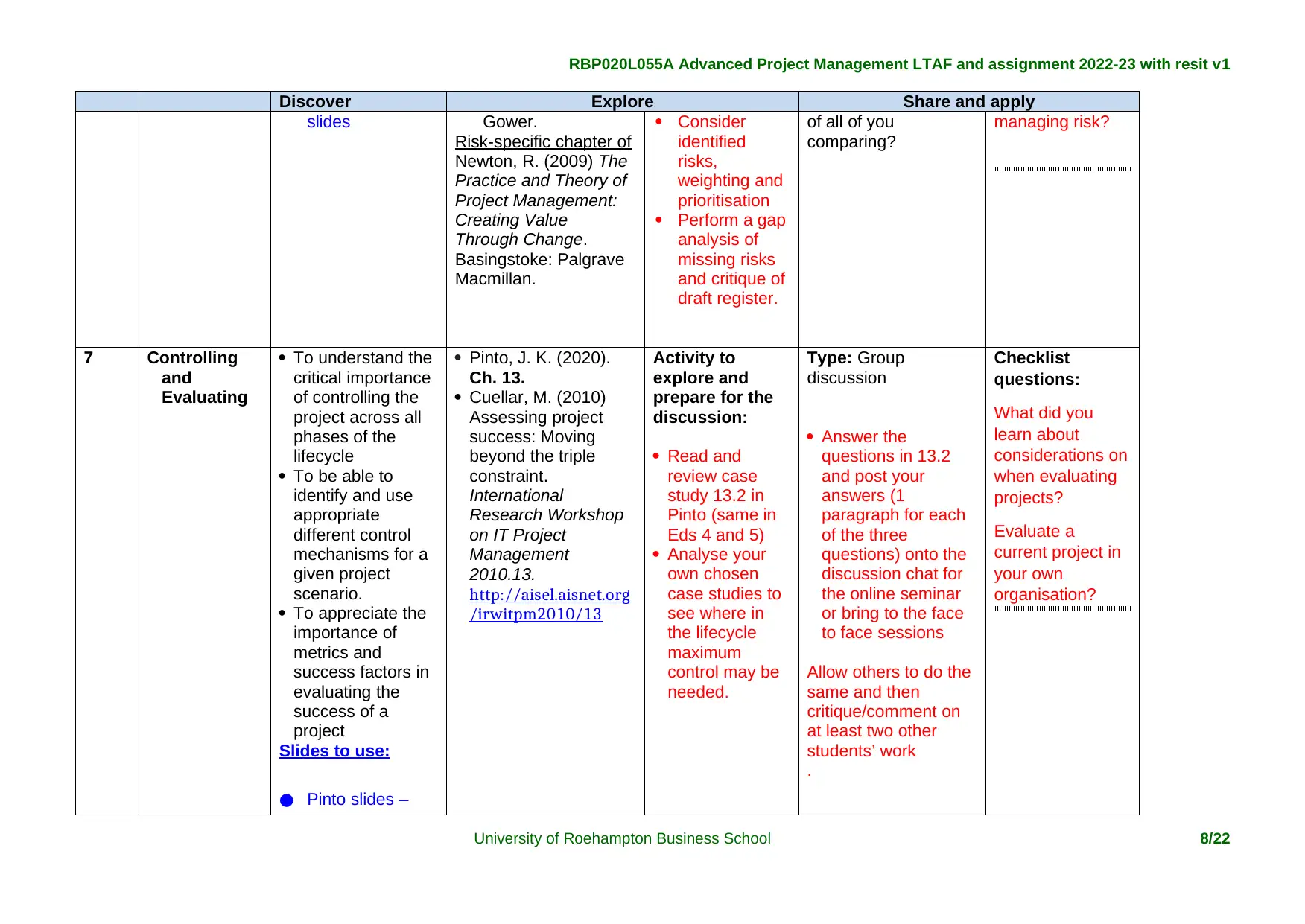
RBP020L055A Advanced Project Management LTAF and assignment 2022-23 with resit v1
Discover Explore Share and apply
slides Gower.
Risk-specific chapter of
Newton, R. (2009) The
Practice and Theory of
Project Management:
Creating Value
Through Change.
Basingstoke: Palgrave
Macmillan.
Consider
identified
risks,
weighting and
prioritisation
Perform a gap
analysis of
missing risks
and critique of
draft register.
of all of you
comparing?
managing risk?
7 Controlling
and
Evaluating
To understand the
critical importance
of controlling the
project across all
phases of the
lifecycle
To be able to
identify and use
appropriate
different control
mechanisms for a
given project
scenario.
To appreciate the
importance of
metrics and
success factors in
evaluating the
success of a
project
Slides to use:
● Pinto slides –
Pinto, J. K. (2020).
Ch. 13.
Cuellar, M. (2010)
Assessing project
success: Moving
beyond the triple
constraint.
International
Research Workshop
on IT Project
Management
2010.13.
http://aisel.aisnet.org
/irwitpm2010/13
Activity to
explore and
prepare for the
discussion:
Read and
review case
study 13.2 in
Pinto (same in
Eds 4 and 5)
Analyse your
own chosen
case studies to
see where in
the lifecycle
maximum
control may be
needed.
Type: Group
discussion
Answer the
questions in 13.2
and post your
answers (1
paragraph for each
of the three
questions) onto the
discussion chat for
the online seminar
or bring to the face
to face sessions
Allow others to do the
same and then
critique/comment on
at least two other
students’ work
.
Checklist
questions:
What did you
learn about
considerations on
when evaluating
projects?
Evaluate a
current project in
your own
organisation?
University of Roehampton Business School 8/22
Discover Explore Share and apply
slides Gower.
Risk-specific chapter of
Newton, R. (2009) The
Practice and Theory of
Project Management:
Creating Value
Through Change.
Basingstoke: Palgrave
Macmillan.
Consider
identified
risks,
weighting and
prioritisation
Perform a gap
analysis of
missing risks
and critique of
draft register.
of all of you
comparing?
managing risk?
7 Controlling
and
Evaluating
To understand the
critical importance
of controlling the
project across all
phases of the
lifecycle
To be able to
identify and use
appropriate
different control
mechanisms for a
given project
scenario.
To appreciate the
importance of
metrics and
success factors in
evaluating the
success of a
project
Slides to use:
● Pinto slides –
Pinto, J. K. (2020).
Ch. 13.
Cuellar, M. (2010)
Assessing project
success: Moving
beyond the triple
constraint.
International
Research Workshop
on IT Project
Management
2010.13.
http://aisel.aisnet.org
/irwitpm2010/13
Activity to
explore and
prepare for the
discussion:
Read and
review case
study 13.2 in
Pinto (same in
Eds 4 and 5)
Analyse your
own chosen
case studies to
see where in
the lifecycle
maximum
control may be
needed.
Type: Group
discussion
Answer the
questions in 13.2
and post your
answers (1
paragraph for each
of the three
questions) onto the
discussion chat for
the online seminar
or bring to the face
to face sessions
Allow others to do the
same and then
critique/comment on
at least two other
students’ work
.
Checklist
questions:
What did you
learn about
considerations on
when evaluating
projects?
Evaluate a
current project in
your own
organisation?
University of Roehampton Business School 8/22
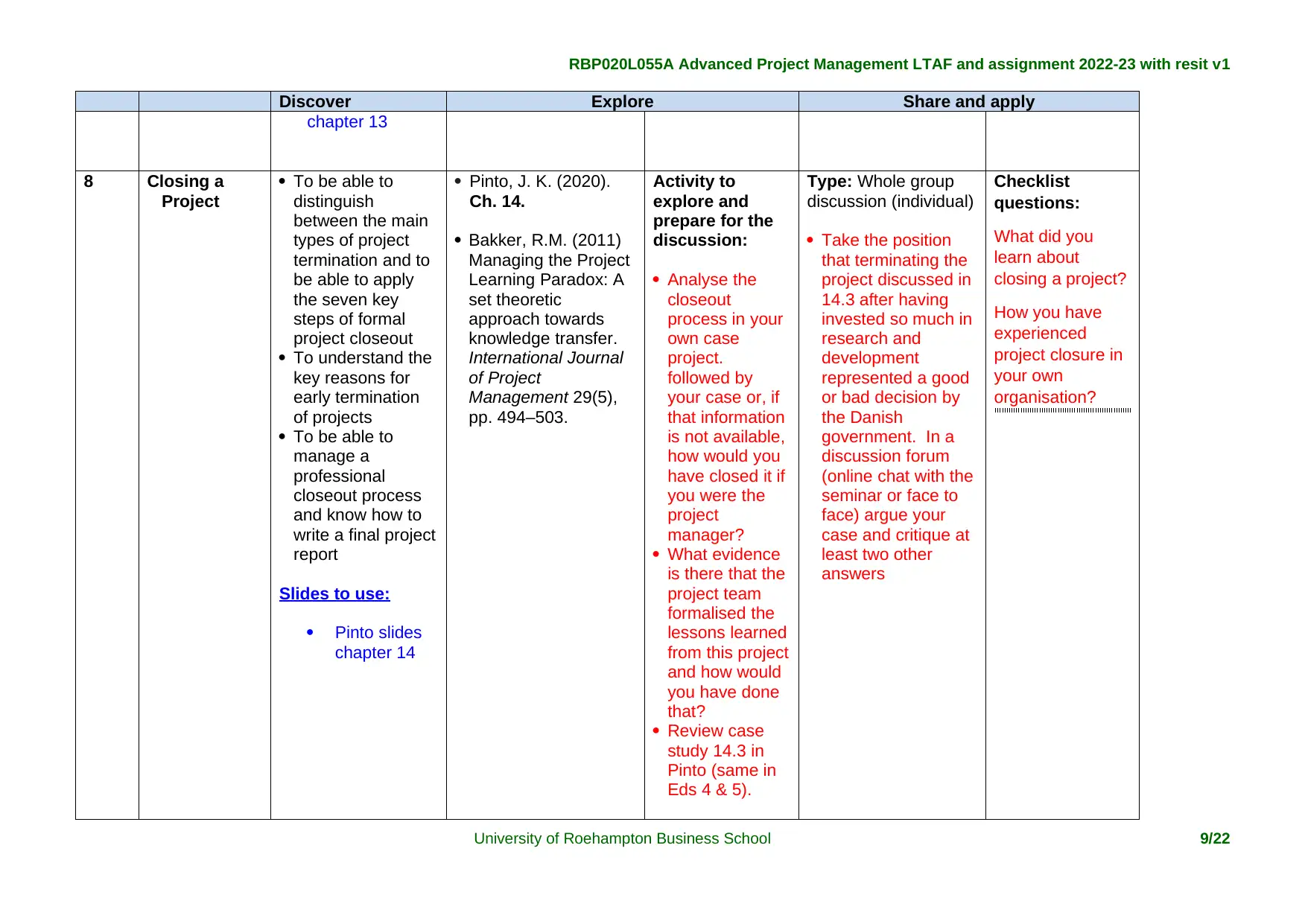
RBP020L055A Advanced Project Management LTAF and assignment 2022-23 with resit v1
Discover Explore Share and apply
chapter 13
8 Closing a
Project
To be able to
distinguish
between the main
types of project
termination and to
be able to apply
the seven key
steps of formal
project closeout
To understand the
key reasons for
early termination
of projects
To be able to
manage a
professional
closeout process
and know how to
write a final project
report
Slides to use:
Pinto slides
chapter 14
Pinto, J. K. (2020).
Ch. 14.
Bakker, R.M. (2011)
Managing the Project
Learning Paradox: A
set theoretic
approach towards
knowledge transfer.
International Journal
of Project
Management 29(5),
pp. 494–503.
Activity to
explore and
prepare for the
discussion:
Analyse the
closeout
process in your
own case
project.
followed by
your case or, if
that information
is not available,
how would you
have closed it if
you were the
project
manager?
What evidence
is there that the
project team
formalised the
lessons learned
from this project
and how would
you have done
that?
Review case
study 14.3 in
Pinto (same in
Eds 4 & 5).
Type: Whole group
discussion (individual)
Take the position
that terminating the
project discussed in
14.3 after having
invested so much in
research and
development
represented a good
or bad decision by
the Danish
government. In a
discussion forum
(online chat with the
seminar or face to
face) argue your
case and critique at
least two other
answers
Checklist
questions:
What did you
learn about
closing a project?
How you have
experienced
project closure in
your own
organisation?
University of Roehampton Business School 9/22
Discover Explore Share and apply
chapter 13
8 Closing a
Project
To be able to
distinguish
between the main
types of project
termination and to
be able to apply
the seven key
steps of formal
project closeout
To understand the
key reasons for
early termination
of projects
To be able to
manage a
professional
closeout process
and know how to
write a final project
report
Slides to use:
Pinto slides
chapter 14
Pinto, J. K. (2020).
Ch. 14.
Bakker, R.M. (2011)
Managing the Project
Learning Paradox: A
set theoretic
approach towards
knowledge transfer.
International Journal
of Project
Management 29(5),
pp. 494–503.
Activity to
explore and
prepare for the
discussion:
Analyse the
closeout
process in your
own case
project.
followed by
your case or, if
that information
is not available,
how would you
have closed it if
you were the
project
manager?
What evidence
is there that the
project team
formalised the
lessons learned
from this project
and how would
you have done
that?
Review case
study 14.3 in
Pinto (same in
Eds 4 & 5).
Type: Whole group
discussion (individual)
Take the position
that terminating the
project discussed in
14.3 after having
invested so much in
research and
development
represented a good
or bad decision by
the Danish
government. In a
discussion forum
(online chat with the
seminar or face to
face) argue your
case and critique at
least two other
answers
Checklist
questions:
What did you
learn about
closing a project?
How you have
experienced
project closure in
your own
organisation?
University of Roehampton Business School 9/22
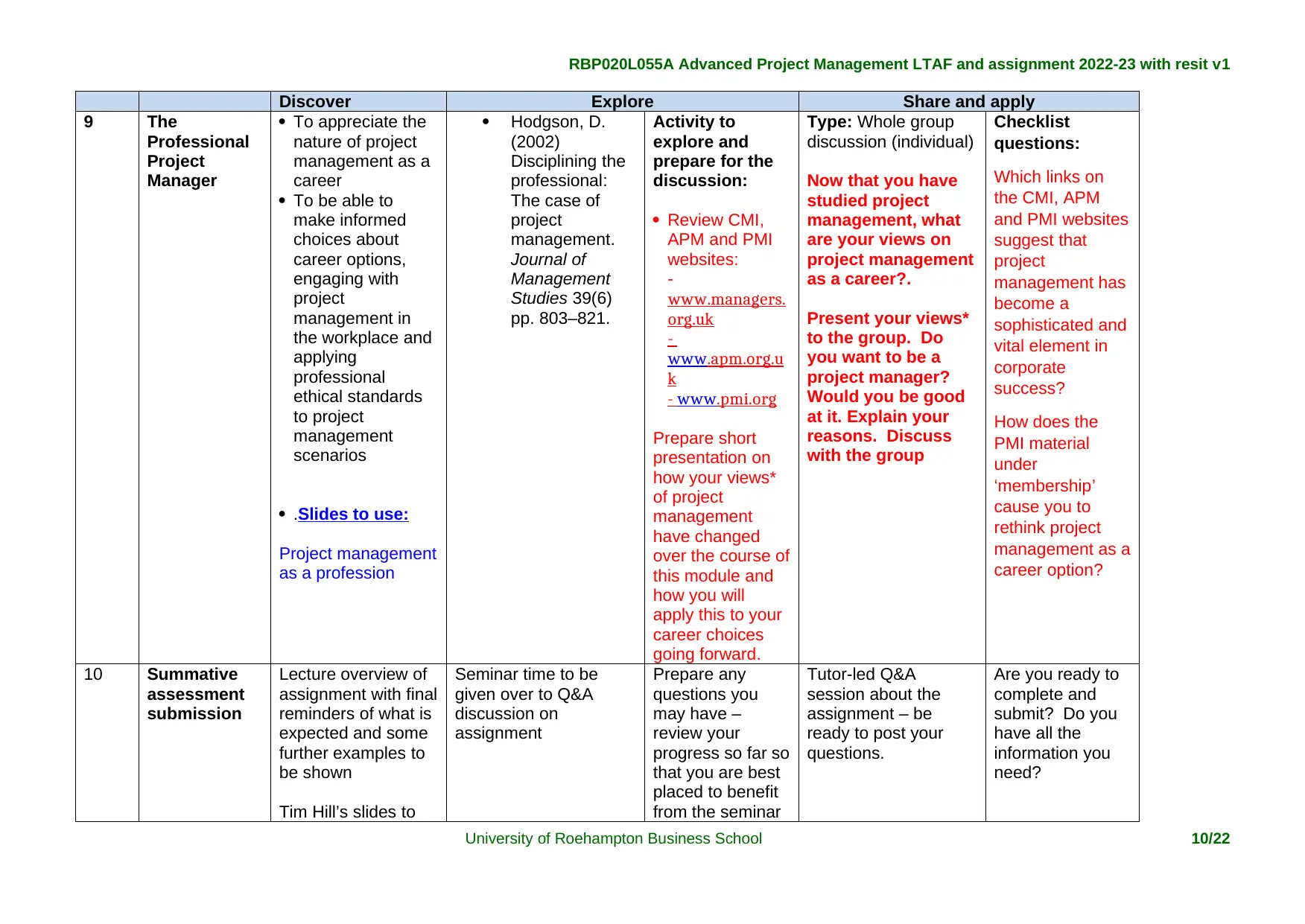
RBP020L055A Advanced Project Management LTAF and assignment 2022-23 with resit v1
Discover Explore Share and apply
9 The
Professional
Project
Manager
To appreciate the
nature of project
management as a
career
To be able to
make informed
choices about
career options,
engaging with
project
management in
the workplace and
applying
professional
ethical standards
to project
management
scenarios
.Slides to use:
Project management
as a profession
Hodgson, D.
(2002)
Disciplining the
professional:
The case of
project
management.
Journal of
Management
Studies 39(6)
pp. 803–821.
Activity to
explore and
prepare for the
discussion:
Review CMI,
APM and PMI
websites:
-
www.managers.
org.uk
-
www.apm.org.u
k
- www.pmi.org
Prepare short
presentation on
how your views*
of project
management
have changed
over the course of
this module and
how you will
apply this to your
career choices
going forward.
Type: Whole group
discussion (individual)
Now that you have
studied project
management, what
are your views on
project management
as a career?.
Present your views*
to the group. Do
you want to be a
project manager?
Would you be good
at it. Explain your
reasons. Discuss
with the group
Checklist
questions:
Which links on
the CMI, APM
and PMI websites
suggest that
project
management has
become a
sophisticated and
vital element in
corporate
success?
How does the
PMI material
under
‘membership’
cause you to
rethink project
management as a
career option?
10 Summative
assessment
submission
Lecture overview of
assignment with final
reminders of what is
expected and some
further examples to
be shown
Tim Hill’s slides to
Seminar time to be
given over to Q&A
discussion on
assignment
Prepare any
questions you
may have –
review your
progress so far so
that you are best
placed to benefit
from the seminar
Tutor-led Q&A
session about the
assignment – be
ready to post your
questions.
Are you ready to
complete and
submit? Do you
have all the
information you
need?
University of Roehampton Business School 10/22
Discover Explore Share and apply
9 The
Professional
Project
Manager
To appreciate the
nature of project
management as a
career
To be able to
make informed
choices about
career options,
engaging with
project
management in
the workplace and
applying
professional
ethical standards
to project
management
scenarios
.Slides to use:
Project management
as a profession
Hodgson, D.
(2002)
Disciplining the
professional:
The case of
project
management.
Journal of
Management
Studies 39(6)
pp. 803–821.
Activity to
explore and
prepare for the
discussion:
Review CMI,
APM and PMI
websites:
-
www.managers.
org.uk
-
www.apm.org.u
k
- www.pmi.org
Prepare short
presentation on
how your views*
of project
management
have changed
over the course of
this module and
how you will
apply this to your
career choices
going forward.
Type: Whole group
discussion (individual)
Now that you have
studied project
management, what
are your views on
project management
as a career?.
Present your views*
to the group. Do
you want to be a
project manager?
Would you be good
at it. Explain your
reasons. Discuss
with the group
Checklist
questions:
Which links on
the CMI, APM
and PMI websites
suggest that
project
management has
become a
sophisticated and
vital element in
corporate
success?
How does the
PMI material
under
‘membership’
cause you to
rethink project
management as a
career option?
10 Summative
assessment
submission
Lecture overview of
assignment with final
reminders of what is
expected and some
further examples to
be shown
Tim Hill’s slides to
Seminar time to be
given over to Q&A
discussion on
assignment
Prepare any
questions you
may have –
review your
progress so far so
that you are best
placed to benefit
from the seminar
Tutor-led Q&A
session about the
assignment – be
ready to post your
questions.
Are you ready to
complete and
submit? Do you
have all the
information you
need?
University of Roehampton Business School 10/22
Secure Best Marks with AI Grader
Need help grading? Try our AI Grader for instant feedback on your assignments.
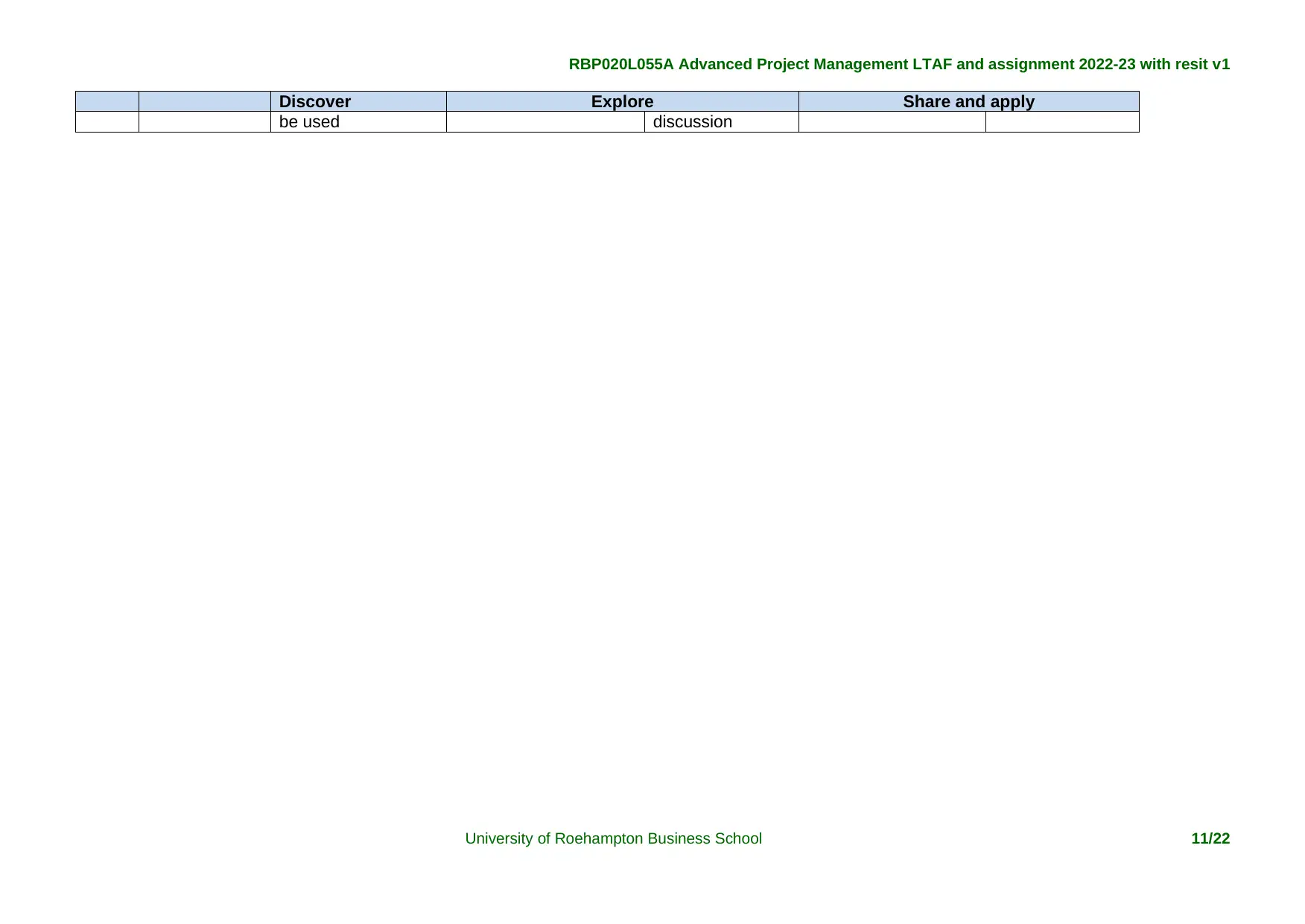
RBP020L055A Advanced Project Management LTAF and assignment 2022-23 with resit v1
Discover Explore Share and apply
be used discussion
University of Roehampton Business School 11/22
Discover Explore Share and apply
be used discussion
University of Roehampton Business School 11/22
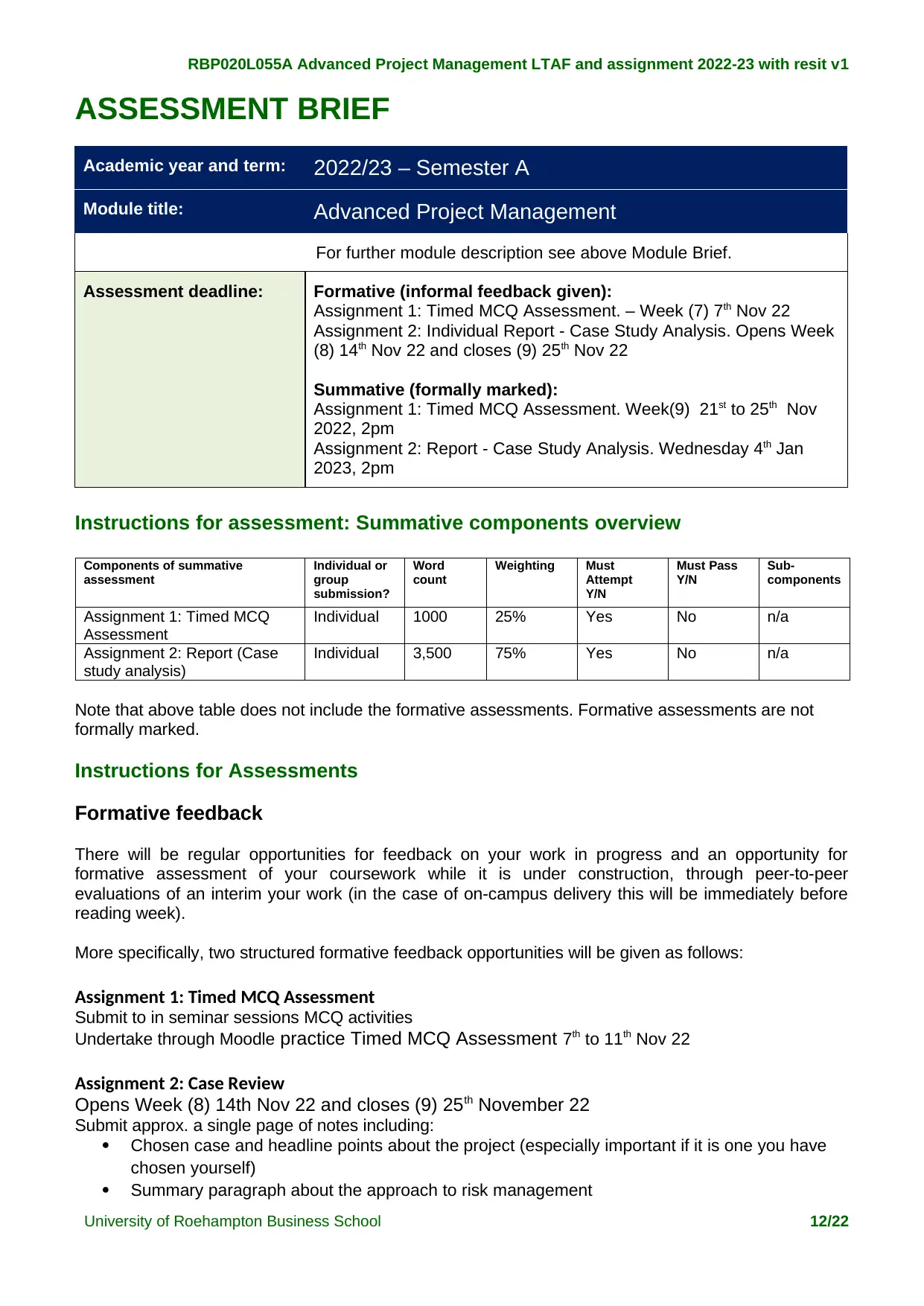
RBP020L055A Advanced Project Management LTAF and assignment 2022-23 with resit v1
ASSESSMENT BRIEF
Academic year and term: 2022/23 – Semester A
Module title: Advanced Project Management
For further module description see above Module Brief.
Assessment deadline: Formative (informal feedback given):
Assignment 1: Timed MCQ Assessment. – Week (7) 7th Nov 22
Assignment 2: Individual Report - Case Study Analysis. Opens Week
(8) 14th Nov 22 and closes (9) 25th Nov 22
Summative (formally marked):
Assignment 1: Timed MCQ Assessment. Week(9) 21st to 25th Nov
2022, 2pm
Assignment 2: Report - Case Study Analysis. Wednesday 4th Jan
2023, 2pm
Instructions for assessment: Summative components overview
Components of summative
assessment
Individual or
group
submission?
Word
count
Weighting Must
Attempt
Y/N
Must Pass
Y/N
Sub-
components
Assignment 1: Timed MCQ
Assessment
Individual 1000 25% Yes No n/a
Assignment 2: Report (Case
study analysis)
Individual 3,500 75% Yes No n/a
Note that above table does not include the formative assessments. Formative assessments are not
formally marked.
Instructions for Assessments
Formative feedback
There will be regular opportunities for feedback on your work in progress and an opportunity for
formative assessment of your coursework while it is under construction, through peer-to-peer
evaluations of an interim your work (in the case of on-campus delivery this will be immediately before
reading week).
More specifically, two structured formative feedback opportunities will be given as follows:
Assignment 1: Timed MCQ Assessment
Submit to in seminar sessions MCQ activities
Undertake through Moodle practice Timed MCQ Assessment 7th to 11th Nov 22
Assignment 2: Case Review
Opens Week (8) 14th Nov 22 and closes (9) 25th November 22
Submit approx. a single page of notes including:
Chosen case and headline points about the project (especially important if it is one you have
chosen yourself)
Summary paragraph about the approach to risk management
University of Roehampton Business School 12/22
ASSESSMENT BRIEF
Academic year and term: 2022/23 – Semester A
Module title: Advanced Project Management
For further module description see above Module Brief.
Assessment deadline: Formative (informal feedback given):
Assignment 1: Timed MCQ Assessment. – Week (7) 7th Nov 22
Assignment 2: Individual Report - Case Study Analysis. Opens Week
(8) 14th Nov 22 and closes (9) 25th Nov 22
Summative (formally marked):
Assignment 1: Timed MCQ Assessment. Week(9) 21st to 25th Nov
2022, 2pm
Assignment 2: Report - Case Study Analysis. Wednesday 4th Jan
2023, 2pm
Instructions for assessment: Summative components overview
Components of summative
assessment
Individual or
group
submission?
Word
count
Weighting Must
Attempt
Y/N
Must Pass
Y/N
Sub-
components
Assignment 1: Timed MCQ
Assessment
Individual 1000 25% Yes No n/a
Assignment 2: Report (Case
study analysis)
Individual 3,500 75% Yes No n/a
Note that above table does not include the formative assessments. Formative assessments are not
formally marked.
Instructions for Assessments
Formative feedback
There will be regular opportunities for feedback on your work in progress and an opportunity for
formative assessment of your coursework while it is under construction, through peer-to-peer
evaluations of an interim your work (in the case of on-campus delivery this will be immediately before
reading week).
More specifically, two structured formative feedback opportunities will be given as follows:
Assignment 1: Timed MCQ Assessment
Submit to in seminar sessions MCQ activities
Undertake through Moodle practice Timed MCQ Assessment 7th to 11th Nov 22
Assignment 2: Case Review
Opens Week (8) 14th Nov 22 and closes (9) 25th November 22
Submit approx. a single page of notes including:
Chosen case and headline points about the project (especially important if it is one you have
chosen yourself)
Summary paragraph about the approach to risk management
University of Roehampton Business School 12/22
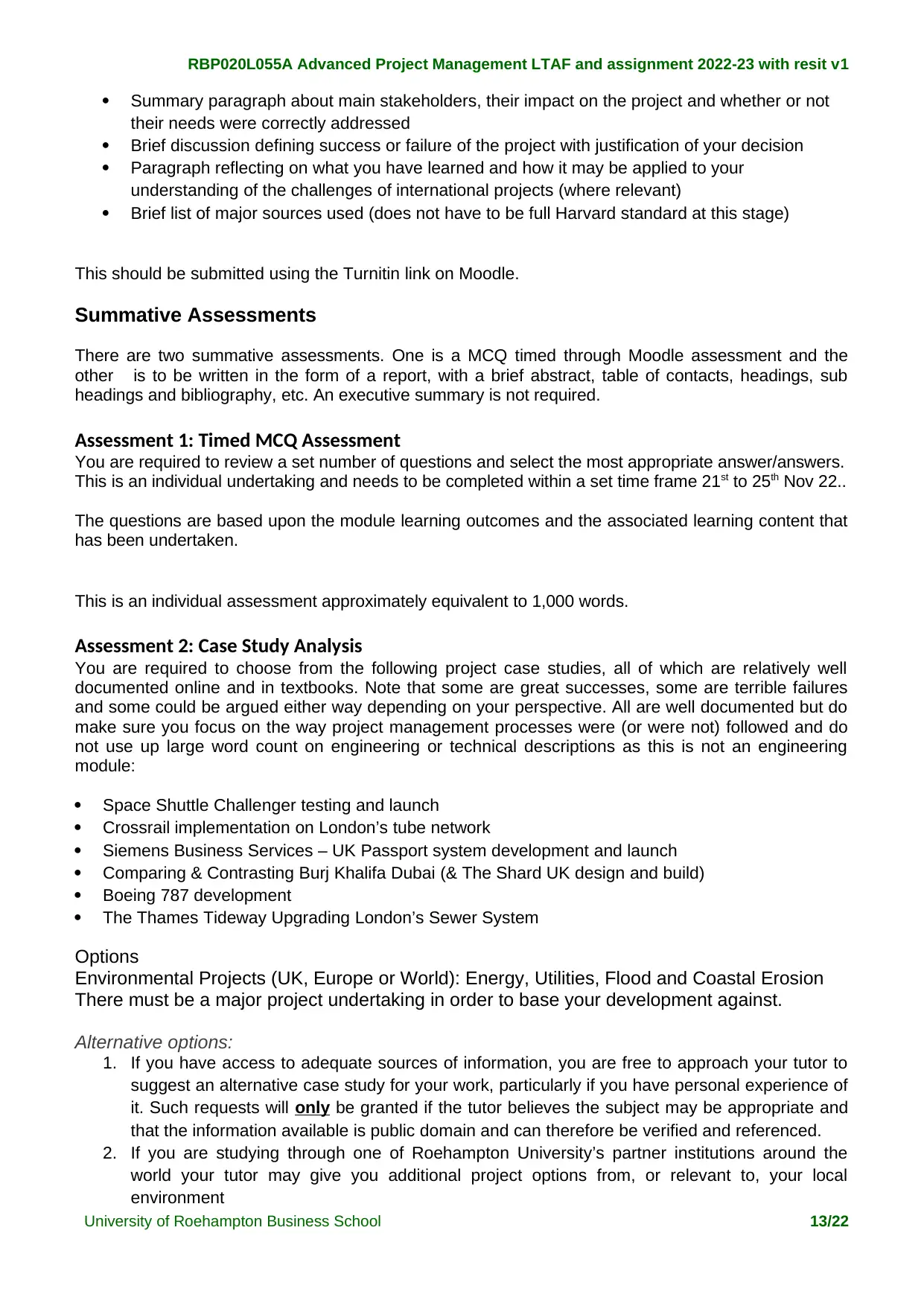
RBP020L055A Advanced Project Management LTAF and assignment 2022-23 with resit v1
Summary paragraph about main stakeholders, their impact on the project and whether or not
their needs were correctly addressed
Brief discussion defining success or failure of the project with justification of your decision
Paragraph reflecting on what you have learned and how it may be applied to your
understanding of the challenges of international projects (where relevant)
Brief list of major sources used (does not have to be full Harvard standard at this stage)
This should be submitted using the Turnitin link on Moodle.
Summative Assessments
There are two summative assessments. One is a MCQ timed through Moodle assessment and the
other is to be written in the form of a report, with a brief abstract, table of contacts, headings, sub
headings and bibliography, etc. An executive summary is not required.
Assessment 1: Timed MCQ Assessment
You are required to review a set number of questions and select the most appropriate answer/answers.
This is an individual undertaking and needs to be completed within a set time frame 21st to 25th Nov 22..
The questions are based upon the module learning outcomes and the associated learning content that
has been undertaken.
This is an individual assessment approximately equivalent to 1,000 words.
Assessment 2: Case Study Analysis
You are required to choose from the following project case studies, all of which are relatively well
documented online and in textbooks. Note that some are great successes, some are terrible failures
and some could be argued either way depending on your perspective. All are well documented but do
make sure you focus on the way project management processes were (or were not) followed and do
not use up large word count on engineering or technical descriptions as this is not an engineering
module:
Space Shuttle Challenger testing and launch
Crossrail implementation on London’s tube network
Siemens Business Services – UK Passport system development and launch
Comparing & Contrasting Burj Khalifa Dubai (& The Shard UK design and build)
Boeing 787 development
The Thames Tideway Upgrading London’s Sewer System
Options
Environmental Projects (UK, Europe or World): Energy, Utilities, Flood and Coastal Erosion
There must be a major project undertaking in order to base your development against.
Alternative options:
1. If you have access to adequate sources of information, you are free to approach your tutor to
suggest an alternative case study for your work, particularly if you have personal experience of
it. Such requests will only be granted if the tutor believes the subject may be appropriate and
that the information available is public domain and can therefore be verified and referenced.
2. If you are studying through one of Roehampton University’s partner institutions around the
world your tutor may give you additional project options from, or relevant to, your local
environment
University of Roehampton Business School 13/22
Summary paragraph about main stakeholders, their impact on the project and whether or not
their needs were correctly addressed
Brief discussion defining success or failure of the project with justification of your decision
Paragraph reflecting on what you have learned and how it may be applied to your
understanding of the challenges of international projects (where relevant)
Brief list of major sources used (does not have to be full Harvard standard at this stage)
This should be submitted using the Turnitin link on Moodle.
Summative Assessments
There are two summative assessments. One is a MCQ timed through Moodle assessment and the
other is to be written in the form of a report, with a brief abstract, table of contacts, headings, sub
headings and bibliography, etc. An executive summary is not required.
Assessment 1: Timed MCQ Assessment
You are required to review a set number of questions and select the most appropriate answer/answers.
This is an individual undertaking and needs to be completed within a set time frame 21st to 25th Nov 22..
The questions are based upon the module learning outcomes and the associated learning content that
has been undertaken.
This is an individual assessment approximately equivalent to 1,000 words.
Assessment 2: Case Study Analysis
You are required to choose from the following project case studies, all of which are relatively well
documented online and in textbooks. Note that some are great successes, some are terrible failures
and some could be argued either way depending on your perspective. All are well documented but do
make sure you focus on the way project management processes were (or were not) followed and do
not use up large word count on engineering or technical descriptions as this is not an engineering
module:
Space Shuttle Challenger testing and launch
Crossrail implementation on London’s tube network
Siemens Business Services – UK Passport system development and launch
Comparing & Contrasting Burj Khalifa Dubai (& The Shard UK design and build)
Boeing 787 development
The Thames Tideway Upgrading London’s Sewer System
Options
Environmental Projects (UK, Europe or World): Energy, Utilities, Flood and Coastal Erosion
There must be a major project undertaking in order to base your development against.
Alternative options:
1. If you have access to adequate sources of information, you are free to approach your tutor to
suggest an alternative case study for your work, particularly if you have personal experience of
it. Such requests will only be granted if the tutor believes the subject may be appropriate and
that the information available is public domain and can therefore be verified and referenced.
2. If you are studying through one of Roehampton University’s partner institutions around the
world your tutor may give you additional project options from, or relevant to, your local
environment
University of Roehampton Business School 13/22
Paraphrase This Document
Need a fresh take? Get an instant paraphrase of this document with our AI Paraphraser
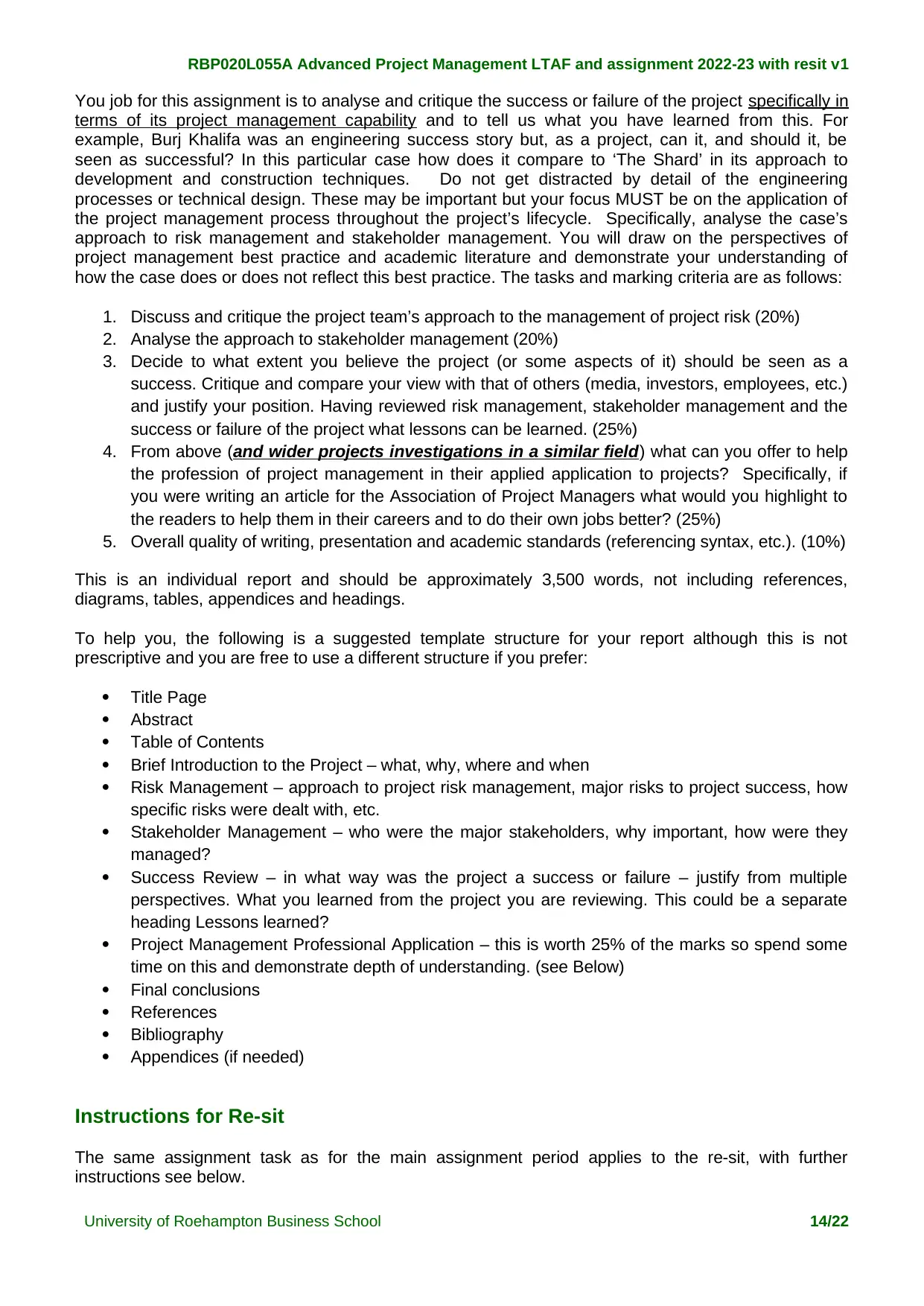
RBP020L055A Advanced Project Management LTAF and assignment 2022-23 with resit v1
You job for this assignment is to analyse and critique the success or failure of the project specifically in
terms of its project management capability and to tell us what you have learned from this. For
example, Burj Khalifa was an engineering success story but, as a project, can it, and should it, be
seen as successful? In this particular case how does it compare to ‘The Shard’ in its approach to
development and construction techniques. Do not get distracted by detail of the engineering
processes or technical design. These may be important but your focus MUST be on the application of
the project management process throughout the project’s lifecycle. Specifically, analyse the case’s
approach to risk management and stakeholder management. You will draw on the perspectives of
project management best practice and academic literature and demonstrate your understanding of
how the case does or does not reflect this best practice. The tasks and marking criteria are as follows:
1. Discuss and critique the project team’s approach to the management of project risk (20%)
2. Analyse the approach to stakeholder management (20%)
3. Decide to what extent you believe the project (or some aspects of it) should be seen as a
success. Critique and compare your view with that of others (media, investors, employees, etc.)
and justify your position. Having reviewed risk management, stakeholder management and the
success or failure of the project what lessons can be learned. (25%)
4. From above (and wider projects investigations in a similar field) what can you offer to help
the profession of project management in their applied application to projects? Specifically, if
you were writing an article for the Association of Project Managers what would you highlight to
the readers to help them in their careers and to do their own jobs better? (25%)
5. Overall quality of writing, presentation and academic standards (referencing syntax, etc.). (10%)
This is an individual report and should be approximately 3,500 words, not including references,
diagrams, tables, appendices and headings.
To help you, the following is a suggested template structure for your report although this is not
prescriptive and you are free to use a different structure if you prefer:
Title Page
Abstract
Table of Contents
Brief Introduction to the Project – what, why, where and when
Risk Management – approach to project risk management, major risks to project success, how
specific risks were dealt with, etc.
Stakeholder Management – who were the major stakeholders, why important, how were they
managed?
Success Review – in what way was the project a success or failure – justify from multiple
perspectives. What you learned from the project you are reviewing. This could be a separate
heading Lessons learned?
Project Management Professional Application – this is worth 25% of the marks so spend some
time on this and demonstrate depth of understanding. (see Below)
Final conclusions
References
Bibliography
Appendices (if needed)
Instructions for Re-sit
The same assignment task as for the main assignment period applies to the re-sit, with further
instructions see below.
University of Roehampton Business School 14/22
You job for this assignment is to analyse and critique the success or failure of the project specifically in
terms of its project management capability and to tell us what you have learned from this. For
example, Burj Khalifa was an engineering success story but, as a project, can it, and should it, be
seen as successful? In this particular case how does it compare to ‘The Shard’ in its approach to
development and construction techniques. Do not get distracted by detail of the engineering
processes or technical design. These may be important but your focus MUST be on the application of
the project management process throughout the project’s lifecycle. Specifically, analyse the case’s
approach to risk management and stakeholder management. You will draw on the perspectives of
project management best practice and academic literature and demonstrate your understanding of
how the case does or does not reflect this best practice. The tasks and marking criteria are as follows:
1. Discuss and critique the project team’s approach to the management of project risk (20%)
2. Analyse the approach to stakeholder management (20%)
3. Decide to what extent you believe the project (or some aspects of it) should be seen as a
success. Critique and compare your view with that of others (media, investors, employees, etc.)
and justify your position. Having reviewed risk management, stakeholder management and the
success or failure of the project what lessons can be learned. (25%)
4. From above (and wider projects investigations in a similar field) what can you offer to help
the profession of project management in their applied application to projects? Specifically, if
you were writing an article for the Association of Project Managers what would you highlight to
the readers to help them in their careers and to do their own jobs better? (25%)
5. Overall quality of writing, presentation and academic standards (referencing syntax, etc.). (10%)
This is an individual report and should be approximately 3,500 words, not including references,
diagrams, tables, appendices and headings.
To help you, the following is a suggested template structure for your report although this is not
prescriptive and you are free to use a different structure if you prefer:
Title Page
Abstract
Table of Contents
Brief Introduction to the Project – what, why, where and when
Risk Management – approach to project risk management, major risks to project success, how
specific risks were dealt with, etc.
Stakeholder Management – who were the major stakeholders, why important, how were they
managed?
Success Review – in what way was the project a success or failure – justify from multiple
perspectives. What you learned from the project you are reviewing. This could be a separate
heading Lessons learned?
Project Management Professional Application – this is worth 25% of the marks so spend some
time on this and demonstrate depth of understanding. (see Below)
Final conclusions
References
Bibliography
Appendices (if needed)
Instructions for Re-sit
The same assignment task as for the main assignment period applies to the re-sit, with further
instructions see below.
University of Roehampton Business School 14/22
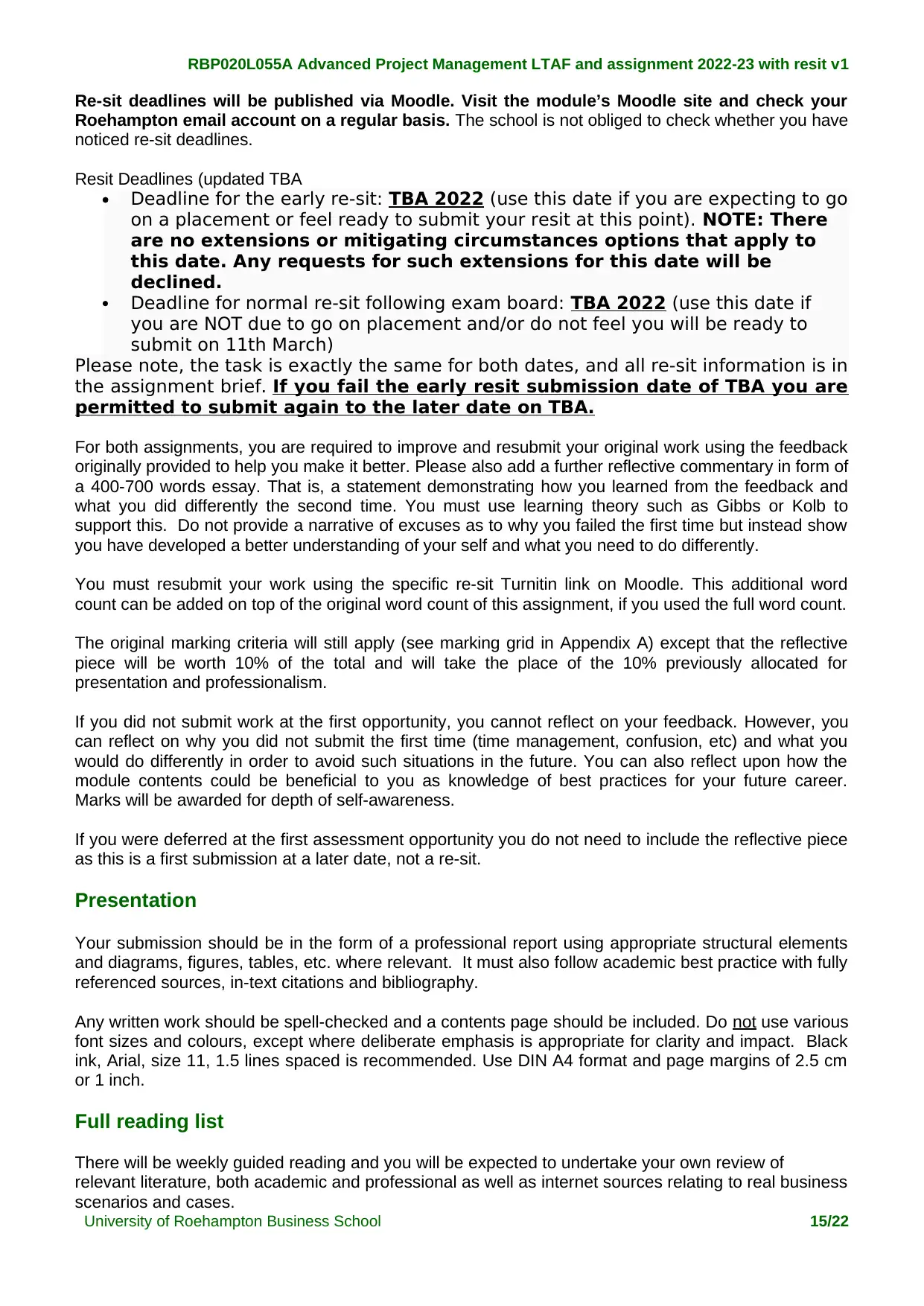
RBP020L055A Advanced Project Management LTAF and assignment 2022-23 with resit v1
Re-sit deadlines will be published via Moodle. Visit the module’s Moodle site and check your
Roehampton email account on a regular basis. The school is not obliged to check whether you have
noticed re-sit deadlines.
Resit Deadlines (updated TBA
Deadline for the early re-sit: TBA 2022 (use this date if you are expecting to go
on a placement or feel ready to submit your resit at this point). NOTE: There
are no extensions or mitigating circumstances options that apply to
this date. Any requests for such extensions for this date will be
declined.
Deadline for normal re-sit following exam board: TBA 2022 (use this date if
you are NOT due to go on placement and/or do not feel you will be ready to
submit on 11th March)
Please note, the task is exactly the same for both dates, and all re-sit information is in
the assignment brief. If you fail the early resit submission date of TBA you are
permitted to submit again to the later date on TBA.
For both assignments, you are required to improve and resubmit your original work using the feedback
originally provided to help you make it better. Please also add a further reflective commentary in form of
a 400-700 words essay. That is, a statement demonstrating how you learned from the feedback and
what you did differently the second time. You must use learning theory such as Gibbs or Kolb to
support this. Do not provide a narrative of excuses as to why you failed the first time but instead show
you have developed a better understanding of your self and what you need to do differently.
You must resubmit your work using the specific re-sit Turnitin link on Moodle. This additional word
count can be added on top of the original word count of this assignment, if you used the full word count.
The original marking criteria will still apply (see marking grid in Appendix A) except that the reflective
piece will be worth 10% of the total and will take the place of the 10% previously allocated for
presentation and professionalism.
If you did not submit work at the first opportunity, you cannot reflect on your feedback. However, you
can reflect on why you did not submit the first time (time management, confusion, etc) and what you
would do differently in order to avoid such situations in the future. You can also reflect upon how the
module contents could be beneficial to you as knowledge of best practices for your future career.
Marks will be awarded for depth of self-awareness.
If you were deferred at the first assessment opportunity you do not need to include the reflective piece
as this is a first submission at a later date, not a re-sit.
Presentation
Your submission should be in the form of a professional report using appropriate structural elements
and diagrams, figures, tables, etc. where relevant. It must also follow academic best practice with fully
referenced sources, in-text citations and bibliography.
Any written work should be spell-checked and a contents page should be included. Do not use various
font sizes and colours, except where deliberate emphasis is appropriate for clarity and impact. Black
ink, Arial, size 11, 1.5 lines spaced is recommended. Use DIN A4 format and page margins of 2.5 cm
or 1 inch.
Full reading list
There will be weekly guided reading and you will be expected to undertake your own review of
relevant literature, both academic and professional as well as internet sources relating to real business
scenarios and cases.
University of Roehampton Business School 15/22
Re-sit deadlines will be published via Moodle. Visit the module’s Moodle site and check your
Roehampton email account on a regular basis. The school is not obliged to check whether you have
noticed re-sit deadlines.
Resit Deadlines (updated TBA
Deadline for the early re-sit: TBA 2022 (use this date if you are expecting to go
on a placement or feel ready to submit your resit at this point). NOTE: There
are no extensions or mitigating circumstances options that apply to
this date. Any requests for such extensions for this date will be
declined.
Deadline for normal re-sit following exam board: TBA 2022 (use this date if
you are NOT due to go on placement and/or do not feel you will be ready to
submit on 11th March)
Please note, the task is exactly the same for both dates, and all re-sit information is in
the assignment brief. If you fail the early resit submission date of TBA you are
permitted to submit again to the later date on TBA.
For both assignments, you are required to improve and resubmit your original work using the feedback
originally provided to help you make it better. Please also add a further reflective commentary in form of
a 400-700 words essay. That is, a statement demonstrating how you learned from the feedback and
what you did differently the second time. You must use learning theory such as Gibbs or Kolb to
support this. Do not provide a narrative of excuses as to why you failed the first time but instead show
you have developed a better understanding of your self and what you need to do differently.
You must resubmit your work using the specific re-sit Turnitin link on Moodle. This additional word
count can be added on top of the original word count of this assignment, if you used the full word count.
The original marking criteria will still apply (see marking grid in Appendix A) except that the reflective
piece will be worth 10% of the total and will take the place of the 10% previously allocated for
presentation and professionalism.
If you did not submit work at the first opportunity, you cannot reflect on your feedback. However, you
can reflect on why you did not submit the first time (time management, confusion, etc) and what you
would do differently in order to avoid such situations in the future. You can also reflect upon how the
module contents could be beneficial to you as knowledge of best practices for your future career.
Marks will be awarded for depth of self-awareness.
If you were deferred at the first assessment opportunity you do not need to include the reflective piece
as this is a first submission at a later date, not a re-sit.
Presentation
Your submission should be in the form of a professional report using appropriate structural elements
and diagrams, figures, tables, etc. where relevant. It must also follow academic best practice with fully
referenced sources, in-text citations and bibliography.
Any written work should be spell-checked and a contents page should be included. Do not use various
font sizes and colours, except where deliberate emphasis is appropriate for clarity and impact. Black
ink, Arial, size 11, 1.5 lines spaced is recommended. Use DIN A4 format and page margins of 2.5 cm
or 1 inch.
Full reading list
There will be weekly guided reading and you will be expected to undertake your own review of
relevant literature, both academic and professional as well as internet sources relating to real business
scenarios and cases.
University of Roehampton Business School 15/22
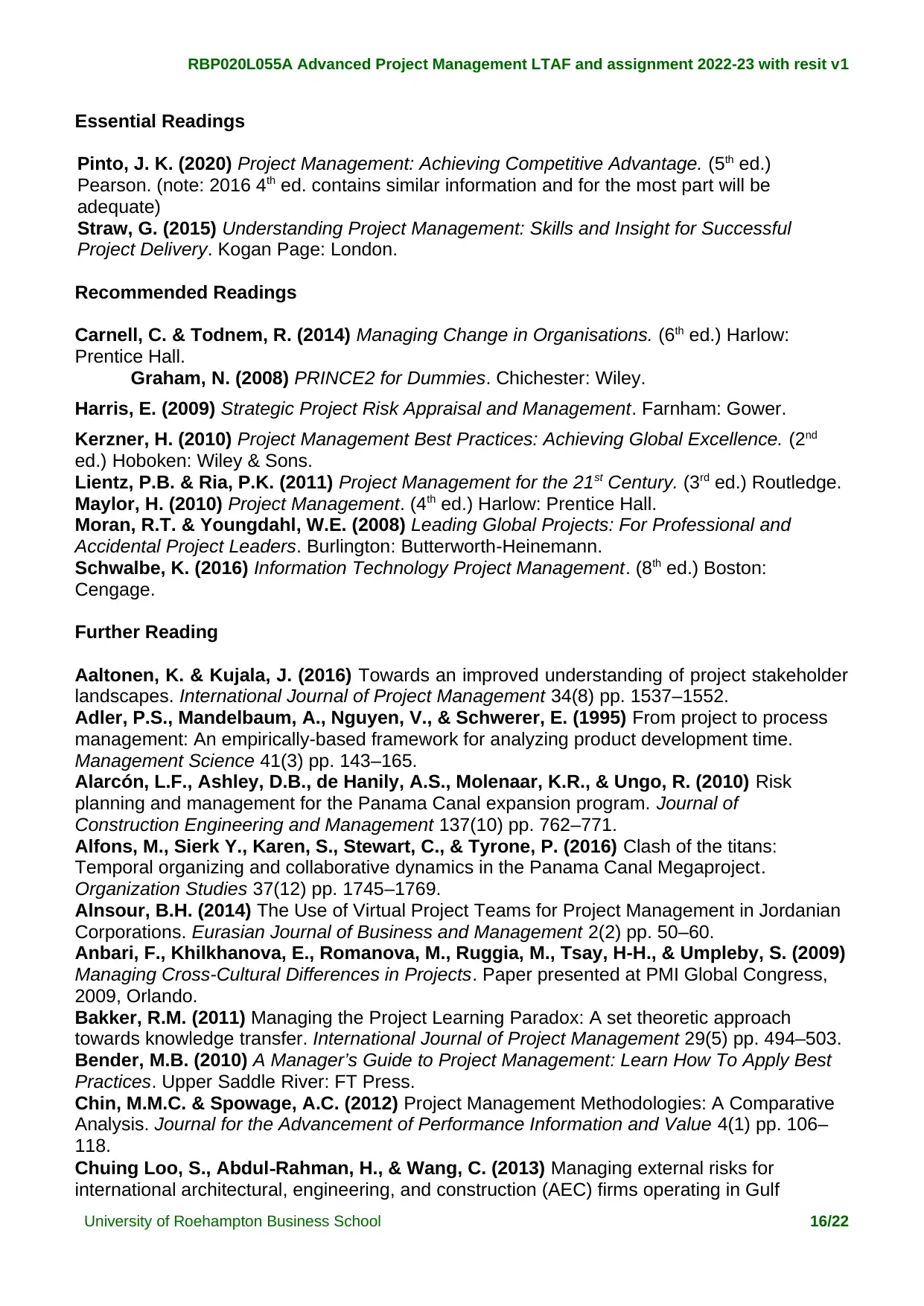
RBP020L055A Advanced Project Management LTAF and assignment 2022-23 with resit v1
Essential Readings
Pinto, J. K. (2020) Project Management: Achieving Competitive Advantage. (5th ed.)
Pearson. (note: 2016 4th ed. contains similar information and for the most part will be
adequate)
Straw, G. (2015) Understanding Project Management: Skills and Insight for Successful
Project Delivery. Kogan Page: London.
Recommended Readings
Carnell, C. & Todnem, R. (2014) Managing Change in Organisations. (6th ed.) Harlow:
Prentice Hall.
Graham, N. (2008) PRINCE2 for Dummies. Chichester: Wiley.
Harris, E. (2009) Strategic Project Risk Appraisal and Management. Farnham: Gower.
Kerzner, H. (2010) Project Management Best Practices: Achieving Global Excellence. (2nd
ed.) Hoboken: Wiley & Sons.
Lientz, P.B. & Ria, P.K. (2011) Project Management for the 21st Century. (3rd ed.) Routledge.
Maylor, H. (2010) Project Management. (4th ed.) Harlow: Prentice Hall.
Moran, R.T. & Youngdahl, W.E. (2008) Leading Global Projects: For Professional and
Accidental Project Leaders. Burlington: Butterworth-Heinemann.
Schwalbe, K. (2016) Information Technology Project Management. (8th ed.) Boston:
Cengage.
Further Reading
Aaltonen, K. & Kujala, J. (2016) Towards an improved understanding of project stakeholder
landscapes. International Journal of Project Management 34(8) pp. 1537–1552.
Adler, P.S., Mandelbaum, A., Nguyen, V., & Schwerer, E. (1995) From project to process
management: An empirically-based framework for analyzing product development time.
Management Science 41(3) pp. 143–165.
Alarcón, L.F., Ashley, D.B., de Hanily, A.S., Molenaar, K.R., & Ungo, R. (2010) Risk
planning and management for the Panama Canal expansion program. Journal of
Construction Engineering and Management 137(10) pp. 762–771.
Alfons, M., Sierk Y., Karen, S., Stewart, C., & Tyrone, P. (2016) Clash of the titans:
Temporal organizing and collaborative dynamics in the Panama Canal Megaproject.
Organization Studies 37(12) pp. 1745–1769.
Alnsour, B.H. (2014) The Use of Virtual Project Teams for Project Management in Jordanian
Corporations. Eurasian Journal of Business and Management 2(2) pp. 50–60.
Anbari, F., Khilkhanova, E., Romanova, M., Ruggia, M., Tsay, H-H., & Umpleby, S. (2009)
Managing Cross-Cultural Differences in Projects. Paper presented at PMI Global Congress,
2009, Orlando.
Bakker, R.M. (2011) Managing the Project Learning Paradox: A set theoretic approach
towards knowledge transfer. International Journal of Project Management 29(5) pp. 494–503.
Bender, M.B. (2010) A Manager’s Guide to Project Management: Learn How To Apply Best
Practices. Upper Saddle River: FT Press.
Chin, M.M.C. & Spowage, A.C. (2012) Project Management Methodologies: A Comparative
Analysis. Journal for the Advancement of Performance Information and Value 4(1) pp. 106–
118.
Chuing Loo, S., Abdul‐Rahman, H., & Wang, C. (2013) Managing external risks for
international architectural, engineering, and construction (AEC) firms operating in Gulf
University of Roehampton Business School 16/22
Essential Readings
Pinto, J. K. (2020) Project Management: Achieving Competitive Advantage. (5th ed.)
Pearson. (note: 2016 4th ed. contains similar information and for the most part will be
adequate)
Straw, G. (2015) Understanding Project Management: Skills and Insight for Successful
Project Delivery. Kogan Page: London.
Recommended Readings
Carnell, C. & Todnem, R. (2014) Managing Change in Organisations. (6th ed.) Harlow:
Prentice Hall.
Graham, N. (2008) PRINCE2 for Dummies. Chichester: Wiley.
Harris, E. (2009) Strategic Project Risk Appraisal and Management. Farnham: Gower.
Kerzner, H. (2010) Project Management Best Practices: Achieving Global Excellence. (2nd
ed.) Hoboken: Wiley & Sons.
Lientz, P.B. & Ria, P.K. (2011) Project Management for the 21st Century. (3rd ed.) Routledge.
Maylor, H. (2010) Project Management. (4th ed.) Harlow: Prentice Hall.
Moran, R.T. & Youngdahl, W.E. (2008) Leading Global Projects: For Professional and
Accidental Project Leaders. Burlington: Butterworth-Heinemann.
Schwalbe, K. (2016) Information Technology Project Management. (8th ed.) Boston:
Cengage.
Further Reading
Aaltonen, K. & Kujala, J. (2016) Towards an improved understanding of project stakeholder
landscapes. International Journal of Project Management 34(8) pp. 1537–1552.
Adler, P.S., Mandelbaum, A., Nguyen, V., & Schwerer, E. (1995) From project to process
management: An empirically-based framework for analyzing product development time.
Management Science 41(3) pp. 143–165.
Alarcón, L.F., Ashley, D.B., de Hanily, A.S., Molenaar, K.R., & Ungo, R. (2010) Risk
planning and management for the Panama Canal expansion program. Journal of
Construction Engineering and Management 137(10) pp. 762–771.
Alfons, M., Sierk Y., Karen, S., Stewart, C., & Tyrone, P. (2016) Clash of the titans:
Temporal organizing and collaborative dynamics in the Panama Canal Megaproject.
Organization Studies 37(12) pp. 1745–1769.
Alnsour, B.H. (2014) The Use of Virtual Project Teams for Project Management in Jordanian
Corporations. Eurasian Journal of Business and Management 2(2) pp. 50–60.
Anbari, F., Khilkhanova, E., Romanova, M., Ruggia, M., Tsay, H-H., & Umpleby, S. (2009)
Managing Cross-Cultural Differences in Projects. Paper presented at PMI Global Congress,
2009, Orlando.
Bakker, R.M. (2011) Managing the Project Learning Paradox: A set theoretic approach
towards knowledge transfer. International Journal of Project Management 29(5) pp. 494–503.
Bender, M.B. (2010) A Manager’s Guide to Project Management: Learn How To Apply Best
Practices. Upper Saddle River: FT Press.
Chin, M.M.C. & Spowage, A.C. (2012) Project Management Methodologies: A Comparative
Analysis. Journal for the Advancement of Performance Information and Value 4(1) pp. 106–
118.
Chuing Loo, S., Abdul‐Rahman, H., & Wang, C. (2013) Managing external risks for
international architectural, engineering, and construction (AEC) firms operating in Gulf
University of Roehampton Business School 16/22
Secure Best Marks with AI Grader
Need help grading? Try our AI Grader for instant feedback on your assignments.
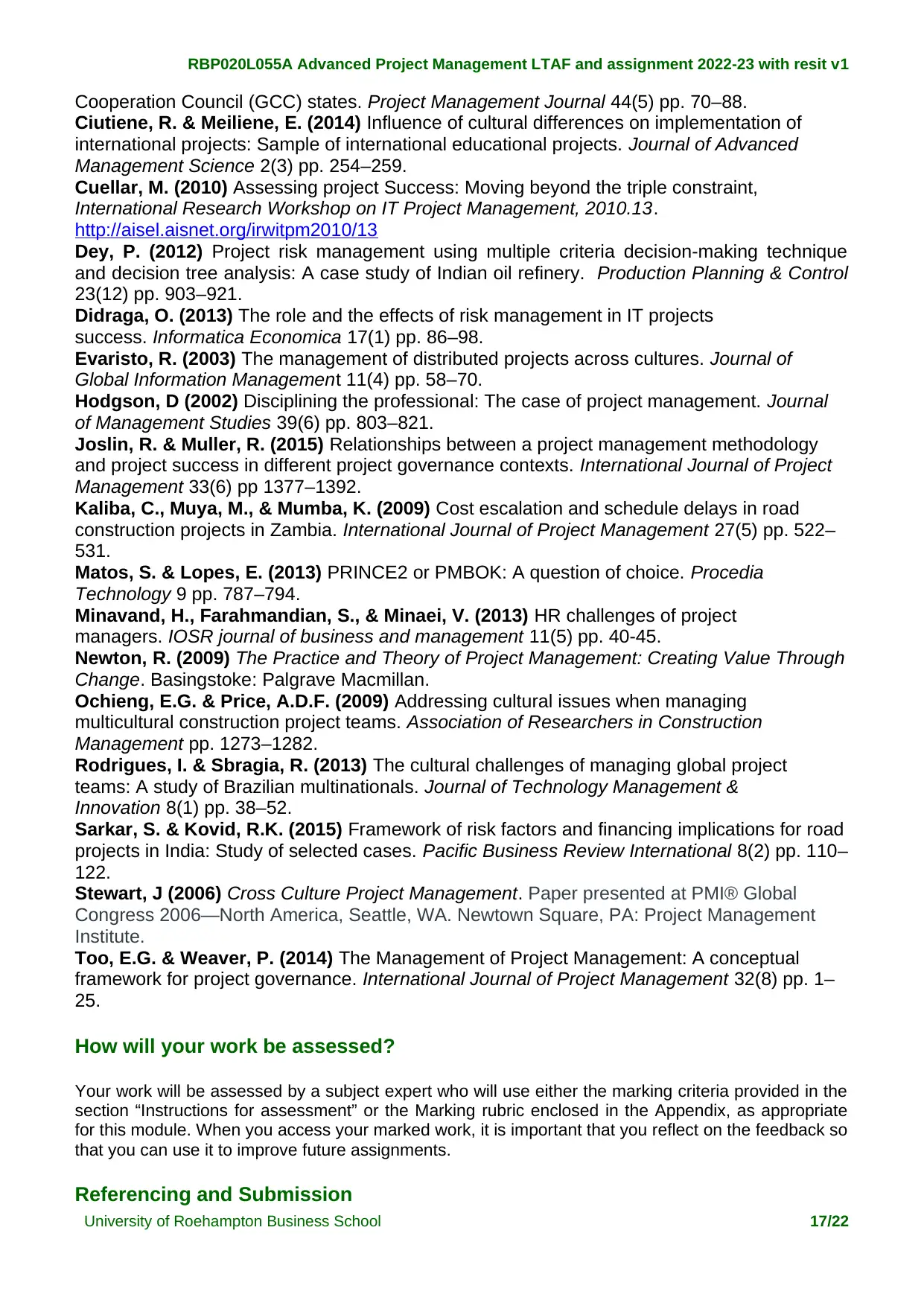
RBP020L055A Advanced Project Management LTAF and assignment 2022-23 with resit v1
Cooperation Council (GCC) states. Project Management Journal 44(5) pp. 70–88.
Ciutiene, R. & Meiliene, E. (2014) Influence of cultural differences on implementation of
international projects: Sample of international educational projects. Journal of Advanced
Management Science 2(3) pp. 254–259.
Cuellar, M. (2010) Assessing project Success: Moving beyond the triple constraint,
International Research Workshop on IT Project Management, 2010.13.
http://aisel.aisnet.org/irwitpm2010/13
Dey, P. (2012) Project risk management using multiple criteria decision-making technique
and decision tree analysis: A case study of Indian oil refinery. Production Planning & Control
23(12) pp. 903–921.
Didraga, O. (2013) The role and the effects of risk management in IT projects
success. Informatica Economica 17(1) pp. 86–98.
Evaristo, R. (2003) The management of distributed projects across cultures. Journal of
Global Information Management 11(4) pp. 58–70.
Hodgson, D (2002) Disciplining the professional: The case of project management. Journal
of Management Studies 39(6) pp. 803–821.
Joslin, R. & Muller, R. (2015) Relationships between a project management methodology
and project success in different project governance contexts. International Journal of Project
Management 33(6) pp 1377–1392.
Kaliba, C., Muya, M., & Mumba, K. (2009) Cost escalation and schedule delays in road
construction projects in Zambia. International Journal of Project Management 27(5) pp. 522–
531.
Matos, S. & Lopes, E. (2013) PRINCE2 or PMBOK: A question of choice. Procedia
Technology 9 pp. 787–794.
Minavand, H., Farahmandian, S., & Minaei, V. (2013) HR challenges of project
managers. IOSR journal of business and management 11(5) pp. 40-45.
Newton, R. (2009) The Practice and Theory of Project Management: Creating Value Through
Change. Basingstoke: Palgrave Macmillan.
Ochieng, E.G. & Price, A.D.F. (2009) Addressing cultural issues when managing
multicultural construction project teams. Association of Researchers in Construction
Management pp. 1273–1282.
Rodrigues, I. & Sbragia, R. (2013) The cultural challenges of managing global project
teams: A study of Brazilian multinationals. Journal of Technology Management &
Innovation 8(1) pp. 38–52.
Sarkar, S. & Kovid, R.K. (2015) Framework of risk factors and financing implications for road
projects in India: Study of selected cases. Pacific Business Review International 8(2) pp. 110–
122.
Stewart, J (2006) Cross Culture Project Management. Paper presented at PMI® Global
Congress 2006—North America, Seattle, WA. Newtown Square, PA: Project Management
Institute.
Too, E.G. & Weaver, P. (2014) The Management of Project Management: A conceptual
framework for project governance. International Journal of Project Management 32(8) pp. 1–
25.
How will your work be assessed?
Your work will be assessed by a subject expert who will use either the marking criteria provided in the
section “Instructions for assessment” or the Marking rubric enclosed in the Appendix, as appropriate
for this module. When you access your marked work, it is important that you reflect on the feedback so
that you can use it to improve future assignments.
Referencing and Submission
University of Roehampton Business School 17/22
Cooperation Council (GCC) states. Project Management Journal 44(5) pp. 70–88.
Ciutiene, R. & Meiliene, E. (2014) Influence of cultural differences on implementation of
international projects: Sample of international educational projects. Journal of Advanced
Management Science 2(3) pp. 254–259.
Cuellar, M. (2010) Assessing project Success: Moving beyond the triple constraint,
International Research Workshop on IT Project Management, 2010.13.
http://aisel.aisnet.org/irwitpm2010/13
Dey, P. (2012) Project risk management using multiple criteria decision-making technique
and decision tree analysis: A case study of Indian oil refinery. Production Planning & Control
23(12) pp. 903–921.
Didraga, O. (2013) The role and the effects of risk management in IT projects
success. Informatica Economica 17(1) pp. 86–98.
Evaristo, R. (2003) The management of distributed projects across cultures. Journal of
Global Information Management 11(4) pp. 58–70.
Hodgson, D (2002) Disciplining the professional: The case of project management. Journal
of Management Studies 39(6) pp. 803–821.
Joslin, R. & Muller, R. (2015) Relationships between a project management methodology
and project success in different project governance contexts. International Journal of Project
Management 33(6) pp 1377–1392.
Kaliba, C., Muya, M., & Mumba, K. (2009) Cost escalation and schedule delays in road
construction projects in Zambia. International Journal of Project Management 27(5) pp. 522–
531.
Matos, S. & Lopes, E. (2013) PRINCE2 or PMBOK: A question of choice. Procedia
Technology 9 pp. 787–794.
Minavand, H., Farahmandian, S., & Minaei, V. (2013) HR challenges of project
managers. IOSR journal of business and management 11(5) pp. 40-45.
Newton, R. (2009) The Practice and Theory of Project Management: Creating Value Through
Change. Basingstoke: Palgrave Macmillan.
Ochieng, E.G. & Price, A.D.F. (2009) Addressing cultural issues when managing
multicultural construction project teams. Association of Researchers in Construction
Management pp. 1273–1282.
Rodrigues, I. & Sbragia, R. (2013) The cultural challenges of managing global project
teams: A study of Brazilian multinationals. Journal of Technology Management &
Innovation 8(1) pp. 38–52.
Sarkar, S. & Kovid, R.K. (2015) Framework of risk factors and financing implications for road
projects in India: Study of selected cases. Pacific Business Review International 8(2) pp. 110–
122.
Stewart, J (2006) Cross Culture Project Management. Paper presented at PMI® Global
Congress 2006—North America, Seattle, WA. Newtown Square, PA: Project Management
Institute.
Too, E.G. & Weaver, P. (2014) The Management of Project Management: A conceptual
framework for project governance. International Journal of Project Management 32(8) pp. 1–
25.
How will your work be assessed?
Your work will be assessed by a subject expert who will use either the marking criteria provided in the
section “Instructions for assessment” or the Marking rubric enclosed in the Appendix, as appropriate
for this module. When you access your marked work, it is important that you reflect on the feedback so
that you can use it to improve future assignments.
Referencing and Submission
University of Roehampton Business School 17/22
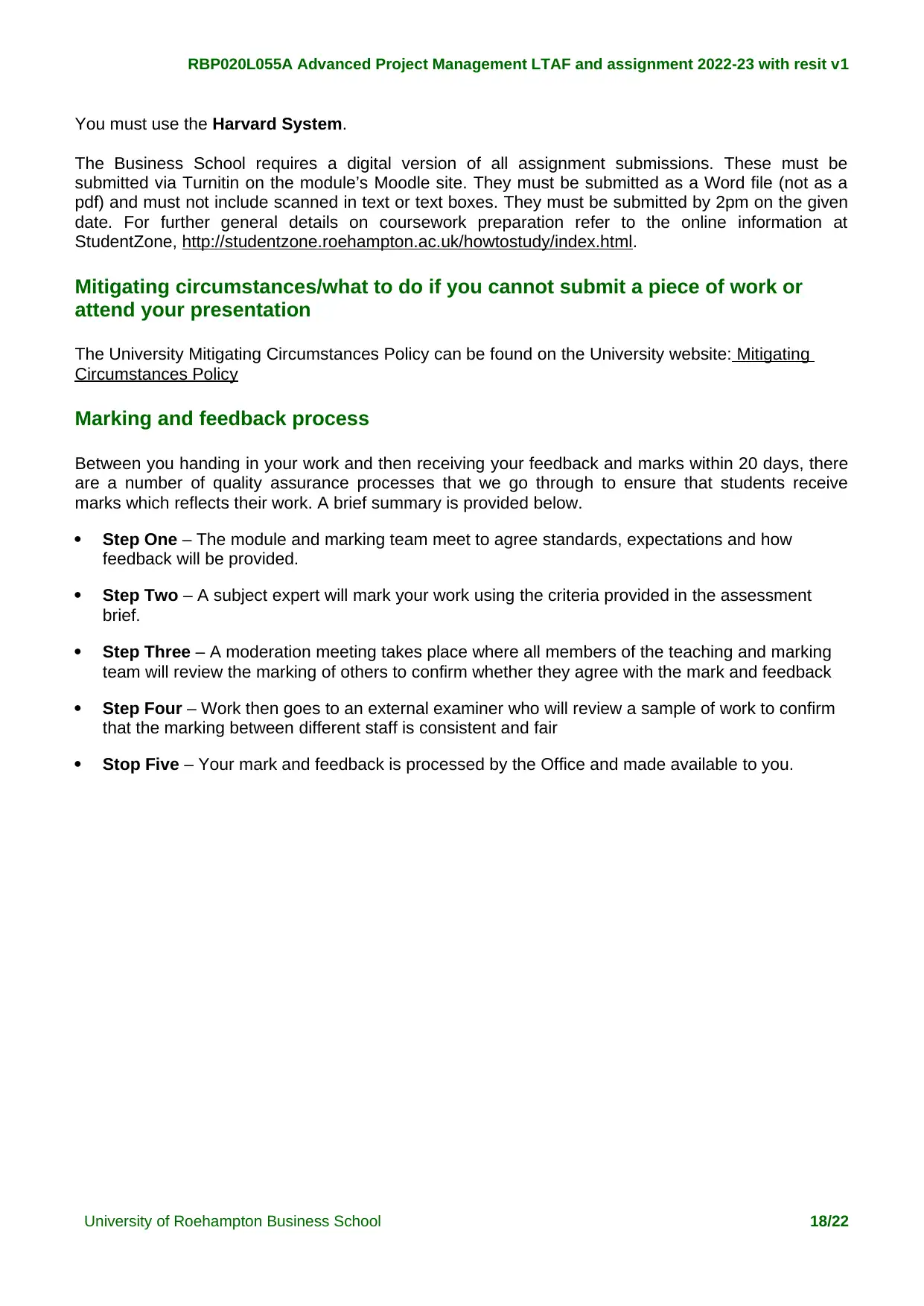
RBP020L055A Advanced Project Management LTAF and assignment 2022-23 with resit v1
You must use the Harvard System.
The Business School requires a digital version of all assignment submissions. These must be
submitted via Turnitin on the module’s Moodle site. They must be submitted as a Word file (not as a
pdf) and must not include scanned in text or text boxes. They must be submitted by 2pm on the given
date. For further general details on coursework preparation refer to the online information at
StudentZone, http://studentzone.roehampton.ac.uk/howtostudy/index.html.
Mitigating circumstances/what to do if you cannot submit a piece of work or
attend your presentation
The University Mitigating Circumstances Policy can be found on the University website: Mitigating
Circumstances Policy
Marking and feedback process
Between you handing in your work and then receiving your feedback and marks within 20 days, there
are a number of quality assurance processes that we go through to ensure that students receive
marks which reflects their work. A brief summary is provided below.
Step One – The module and marking team meet to agree standards, expectations and how
feedback will be provided.
Step Two – A subject expert will mark your work using the criteria provided in the assessment
brief.
Step Three – A moderation meeting takes place where all members of the teaching and marking
team will review the marking of others to confirm whether they agree with the mark and feedback
Step Four – Work then goes to an external examiner who will review a sample of work to confirm
that the marking between different staff is consistent and fair
Stop Five – Your mark and feedback is processed by the Office and made available to you.
University of Roehampton Business School 18/22
You must use the Harvard System.
The Business School requires a digital version of all assignment submissions. These must be
submitted via Turnitin on the module’s Moodle site. They must be submitted as a Word file (not as a
pdf) and must not include scanned in text or text boxes. They must be submitted by 2pm on the given
date. For further general details on coursework preparation refer to the online information at
StudentZone, http://studentzone.roehampton.ac.uk/howtostudy/index.html.
Mitigating circumstances/what to do if you cannot submit a piece of work or
attend your presentation
The University Mitigating Circumstances Policy can be found on the University website: Mitigating
Circumstances Policy
Marking and feedback process
Between you handing in your work and then receiving your feedback and marks within 20 days, there
are a number of quality assurance processes that we go through to ensure that students receive
marks which reflects their work. A brief summary is provided below.
Step One – The module and marking team meet to agree standards, expectations and how
feedback will be provided.
Step Two – A subject expert will mark your work using the criteria provided in the assessment
brief.
Step Three – A moderation meeting takes place where all members of the teaching and marking
team will review the marking of others to confirm whether they agree with the mark and feedback
Step Four – Work then goes to an external examiner who will review a sample of work to confirm
that the marking between different staff is consistent and fair
Stop Five – Your mark and feedback is processed by the Office and made available to you.
University of Roehampton Business School 18/22
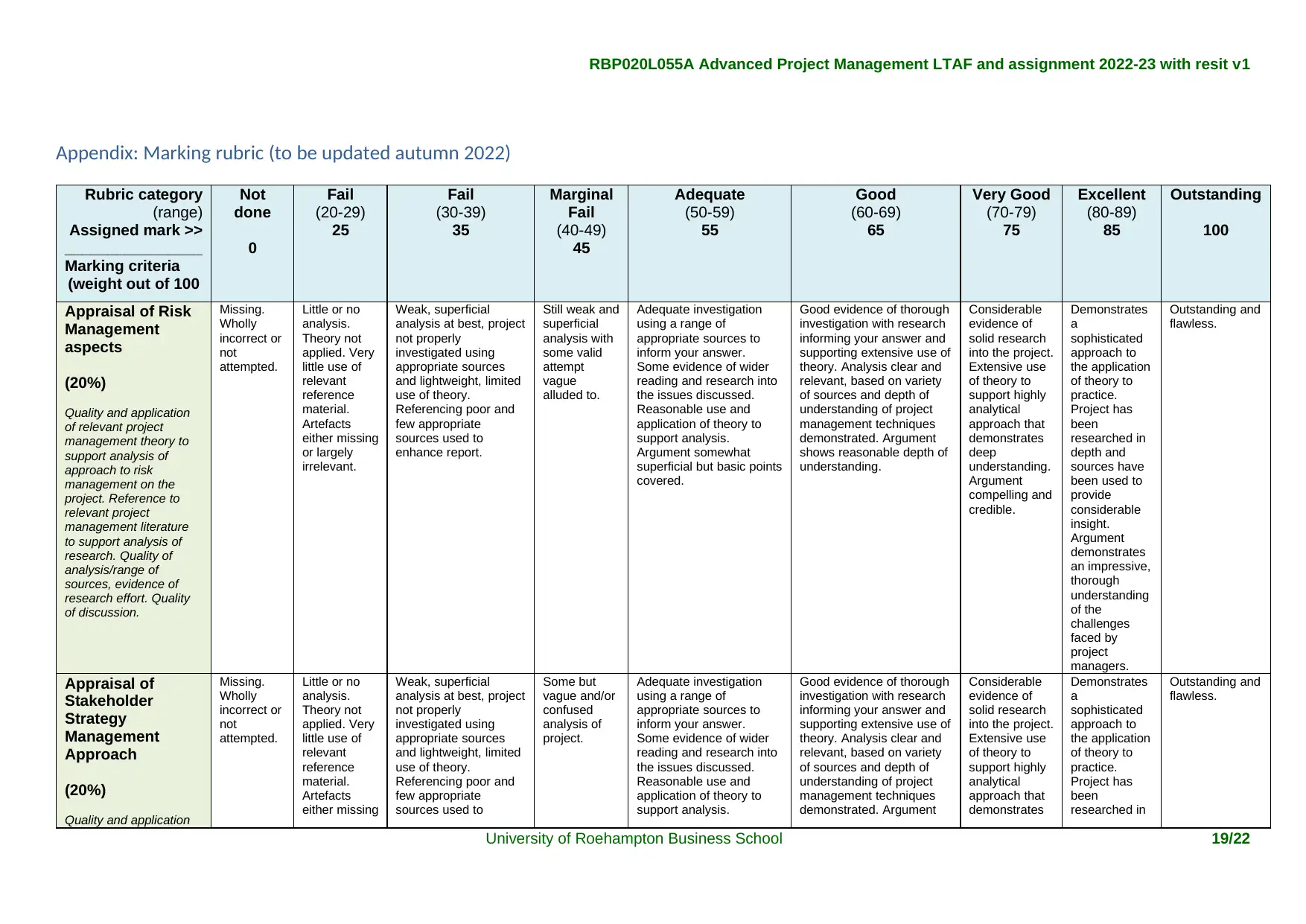
RBP020L055A Advanced Project Management LTAF and assignment 2022-23 with resit v1
Appendix: Marking rubric (to be updated autumn 2022)
Rubric category
(range)
Assigned mark >>
________________
Marking criteria
(weight out of 100
Not
done
0
Fail
(20-29)
25
Fail
(30-39)
35
Marginal
Fail
(40-49)
45
Adequate
(50-59)
55
Good
(60-69)
65
Very Good
(70-79)
75
Excellent
(80-89)
85
Outstanding
100
Appraisal of Risk
Management
aspects
(20%)
Quality and application
of relevant project
management theory to
support analysis of
approach to risk
management on the
project. Reference to
relevant project
management literature
to support analysis of
research. Quality of
analysis/range of
sources, evidence of
research effort. Quality
of discussion.
Missing.
Wholly
incorrect or
not
attempted.
Little or no
analysis.
Theory not
applied. Very
little use of
relevant
reference
material.
Artefacts
either missing
or largely
irrelevant.
Weak, superficial
analysis at best, project
not properly
investigated using
appropriate sources
and lightweight, limited
use of theory.
Referencing poor and
few appropriate
sources used to
enhance report.
Still weak and
superficial
analysis with
some valid
attempt
vague
alluded to.
Adequate investigation
using a range of
appropriate sources to
inform your answer.
Some evidence of wider
reading and research into
the issues discussed.
Reasonable use and
application of theory to
support analysis.
Argument somewhat
superficial but basic points
covered.
Good evidence of thorough
investigation with research
informing your answer and
supporting extensive use of
theory. Analysis clear and
relevant, based on variety
of sources and depth of
understanding of project
management techniques
demonstrated. Argument
shows reasonable depth of
understanding.
Considerable
evidence of
solid research
into the project.
Extensive use
of theory to
support highly
analytical
approach that
demonstrates
deep
understanding.
Argument
compelling and
credible.
Demonstrates
a
sophisticated
approach to
the application
of theory to
practice.
Project has
been
researched in
depth and
sources have
been used to
provide
considerable
insight.
Argument
demonstrates
an impressive,
thorough
understanding
of the
challenges
faced by
project
managers.
Outstanding and
flawless.
Appraisal of
Stakeholder
Strategy
Management
Approach
(20%)
Quality and application
Missing.
Wholly
incorrect or
not
attempted.
Little or no
analysis.
Theory not
applied. Very
little use of
relevant
reference
material.
Artefacts
either missing
Weak, superficial
analysis at best, project
not properly
investigated using
appropriate sources
and lightweight, limited
use of theory.
Referencing poor and
few appropriate
sources used to
Some but
vague and/or
confused
analysis of
project.
Adequate investigation
using a range of
appropriate sources to
inform your answer.
Some evidence of wider
reading and research into
the issues discussed.
Reasonable use and
application of theory to
support analysis.
Good evidence of thorough
investigation with research
informing your answer and
supporting extensive use of
theory. Analysis clear and
relevant, based on variety
of sources and depth of
understanding of project
management techniques
demonstrated. Argument
Considerable
evidence of
solid research
into the project.
Extensive use
of theory to
support highly
analytical
approach that
demonstrates
Demonstrates
a
sophisticated
approach to
the application
of theory to
practice.
Project has
been
researched in
Outstanding and
flawless.
University of Roehampton Business School 19/22
Appendix: Marking rubric (to be updated autumn 2022)
Rubric category
(range)
Assigned mark >>
________________
Marking criteria
(weight out of 100
Not
done
0
Fail
(20-29)
25
Fail
(30-39)
35
Marginal
Fail
(40-49)
45
Adequate
(50-59)
55
Good
(60-69)
65
Very Good
(70-79)
75
Excellent
(80-89)
85
Outstanding
100
Appraisal of Risk
Management
aspects
(20%)
Quality and application
of relevant project
management theory to
support analysis of
approach to risk
management on the
project. Reference to
relevant project
management literature
to support analysis of
research. Quality of
analysis/range of
sources, evidence of
research effort. Quality
of discussion.
Missing.
Wholly
incorrect or
not
attempted.
Little or no
analysis.
Theory not
applied. Very
little use of
relevant
reference
material.
Artefacts
either missing
or largely
irrelevant.
Weak, superficial
analysis at best, project
not properly
investigated using
appropriate sources
and lightweight, limited
use of theory.
Referencing poor and
few appropriate
sources used to
enhance report.
Still weak and
superficial
analysis with
some valid
attempt
vague
alluded to.
Adequate investigation
using a range of
appropriate sources to
inform your answer.
Some evidence of wider
reading and research into
the issues discussed.
Reasonable use and
application of theory to
support analysis.
Argument somewhat
superficial but basic points
covered.
Good evidence of thorough
investigation with research
informing your answer and
supporting extensive use of
theory. Analysis clear and
relevant, based on variety
of sources and depth of
understanding of project
management techniques
demonstrated. Argument
shows reasonable depth of
understanding.
Considerable
evidence of
solid research
into the project.
Extensive use
of theory to
support highly
analytical
approach that
demonstrates
deep
understanding.
Argument
compelling and
credible.
Demonstrates
a
sophisticated
approach to
the application
of theory to
practice.
Project has
been
researched in
depth and
sources have
been used to
provide
considerable
insight.
Argument
demonstrates
an impressive,
thorough
understanding
of the
challenges
faced by
project
managers.
Outstanding and
flawless.
Appraisal of
Stakeholder
Strategy
Management
Approach
(20%)
Quality and application
Missing.
Wholly
incorrect or
not
attempted.
Little or no
analysis.
Theory not
applied. Very
little use of
relevant
reference
material.
Artefacts
either missing
Weak, superficial
analysis at best, project
not properly
investigated using
appropriate sources
and lightweight, limited
use of theory.
Referencing poor and
few appropriate
sources used to
Some but
vague and/or
confused
analysis of
project.
Adequate investigation
using a range of
appropriate sources to
inform your answer.
Some evidence of wider
reading and research into
the issues discussed.
Reasonable use and
application of theory to
support analysis.
Good evidence of thorough
investigation with research
informing your answer and
supporting extensive use of
theory. Analysis clear and
relevant, based on variety
of sources and depth of
understanding of project
management techniques
demonstrated. Argument
Considerable
evidence of
solid research
into the project.
Extensive use
of theory to
support highly
analytical
approach that
demonstrates
Demonstrates
a
sophisticated
approach to
the application
of theory to
practice.
Project has
been
researched in
Outstanding and
flawless.
University of Roehampton Business School 19/22
Paraphrase This Document
Need a fresh take? Get an instant paraphrase of this document with our AI Paraphraser
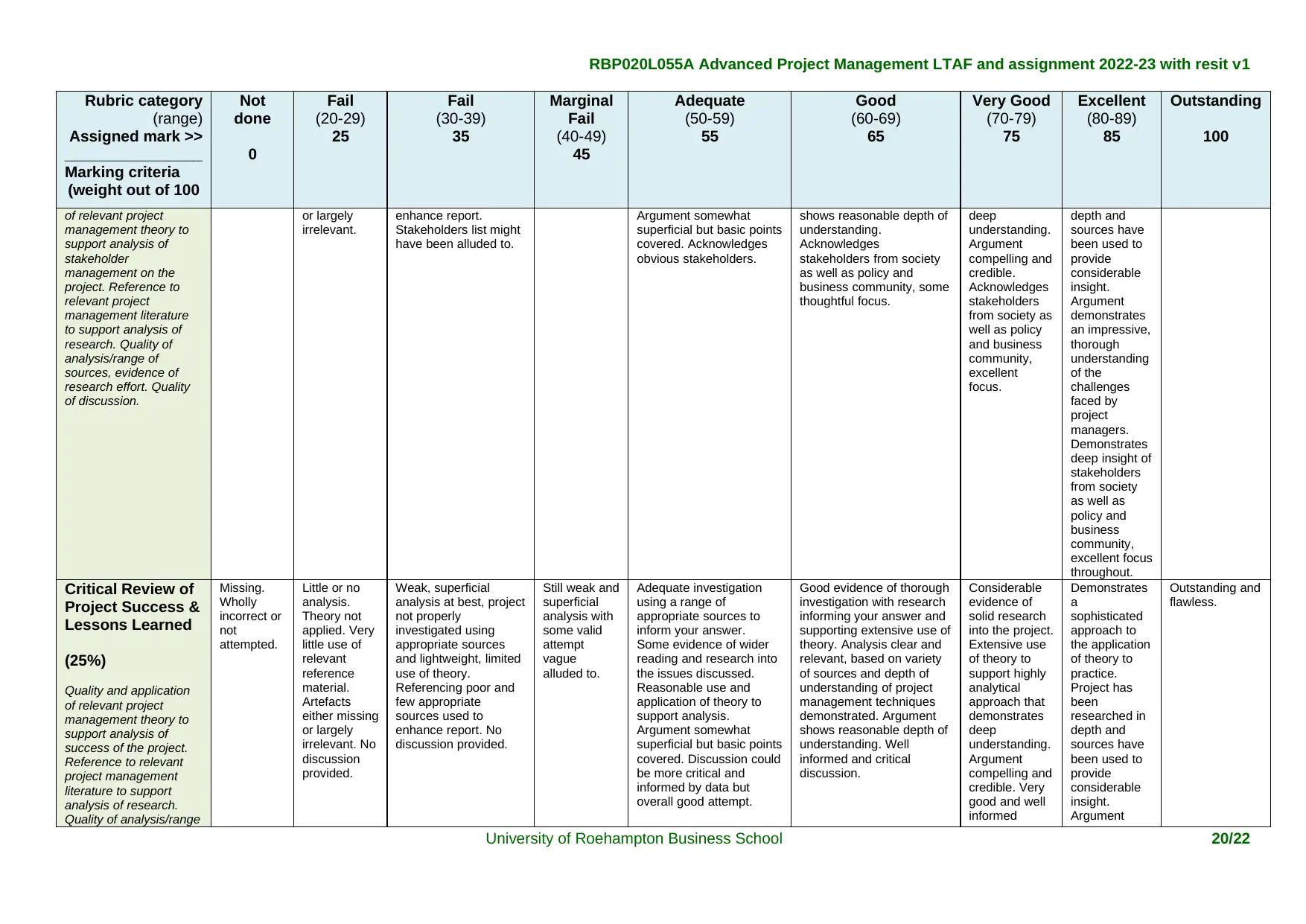
RBP020L055A Advanced Project Management LTAF and assignment 2022-23 with resit v1
Rubric category
(range)
Assigned mark >>
________________
Marking criteria
(weight out of 100
Not
done
0
Fail
(20-29)
25
Fail
(30-39)
35
Marginal
Fail
(40-49)
45
Adequate
(50-59)
55
Good
(60-69)
65
Very Good
(70-79)
75
Excellent
(80-89)
85
Outstanding
100
of relevant project
management theory to
support analysis of
stakeholder
management on the
project. Reference to
relevant project
management literature
to support analysis of
research. Quality of
analysis/range of
sources, evidence of
research effort. Quality
of discussion.
or largely
irrelevant.
enhance report.
Stakeholders list might
have been alluded to.
Argument somewhat
superficial but basic points
covered. Acknowledges
obvious stakeholders.
shows reasonable depth of
understanding.
Acknowledges
stakeholders from society
as well as policy and
business community, some
thoughtful focus.
deep
understanding.
Argument
compelling and
credible.
Acknowledges
stakeholders
from society as
well as policy
and business
community,
excellent
focus.
depth and
sources have
been used to
provide
considerable
insight.
Argument
demonstrates
an impressive,
thorough
understanding
of the
challenges
faced by
project
managers.
Demonstrates
deep insight of
stakeholders
from society
as well as
policy and
business
community,
excellent focus
throughout.
Critical Review of
Project Success &
Lessons Learned
(25%)
Quality and application
of relevant project
management theory to
support analysis of
success of the project.
Reference to relevant
project management
literature to support
analysis of research.
Quality of analysis/range
Missing.
Wholly
incorrect or
not
attempted.
Little or no
analysis.
Theory not
applied. Very
little use of
relevant
reference
material.
Artefacts
either missing
or largely
irrelevant. No
discussion
provided.
Weak, superficial
analysis at best, project
not properly
investigated using
appropriate sources
and lightweight, limited
use of theory.
Referencing poor and
few appropriate
sources used to
enhance report. No
discussion provided.
Still weak and
superficial
analysis with
some valid
attempt
vague
alluded to.
Adequate investigation
using a range of
appropriate sources to
inform your answer.
Some evidence of wider
reading and research into
the issues discussed.
Reasonable use and
application of theory to
support analysis.
Argument somewhat
superficial but basic points
covered. Discussion could
be more critical and
informed by data but
overall good attempt.
Good evidence of thorough
investigation with research
informing your answer and
supporting extensive use of
theory. Analysis clear and
relevant, based on variety
of sources and depth of
understanding of project
management techniques
demonstrated. Argument
shows reasonable depth of
understanding. Well
informed and critical
discussion.
Considerable
evidence of
solid research
into the project.
Extensive use
of theory to
support highly
analytical
approach that
demonstrates
deep
understanding.
Argument
compelling and
credible. Very
good and well
informed
Demonstrates
a
sophisticated
approach to
the application
of theory to
practice.
Project has
been
researched in
depth and
sources have
been used to
provide
considerable
insight.
Argument
Outstanding and
flawless.
University of Roehampton Business School 20/22
Rubric category
(range)
Assigned mark >>
________________
Marking criteria
(weight out of 100
Not
done
0
Fail
(20-29)
25
Fail
(30-39)
35
Marginal
Fail
(40-49)
45
Adequate
(50-59)
55
Good
(60-69)
65
Very Good
(70-79)
75
Excellent
(80-89)
85
Outstanding
100
of relevant project
management theory to
support analysis of
stakeholder
management on the
project. Reference to
relevant project
management literature
to support analysis of
research. Quality of
analysis/range of
sources, evidence of
research effort. Quality
of discussion.
or largely
irrelevant.
enhance report.
Stakeholders list might
have been alluded to.
Argument somewhat
superficial but basic points
covered. Acknowledges
obvious stakeholders.
shows reasonable depth of
understanding.
Acknowledges
stakeholders from society
as well as policy and
business community, some
thoughtful focus.
deep
understanding.
Argument
compelling and
credible.
Acknowledges
stakeholders
from society as
well as policy
and business
community,
excellent
focus.
depth and
sources have
been used to
provide
considerable
insight.
Argument
demonstrates
an impressive,
thorough
understanding
of the
challenges
faced by
project
managers.
Demonstrates
deep insight of
stakeholders
from society
as well as
policy and
business
community,
excellent focus
throughout.
Critical Review of
Project Success &
Lessons Learned
(25%)
Quality and application
of relevant project
management theory to
support analysis of
success of the project.
Reference to relevant
project management
literature to support
analysis of research.
Quality of analysis/range
Missing.
Wholly
incorrect or
not
attempted.
Little or no
analysis.
Theory not
applied. Very
little use of
relevant
reference
material.
Artefacts
either missing
or largely
irrelevant. No
discussion
provided.
Weak, superficial
analysis at best, project
not properly
investigated using
appropriate sources
and lightweight, limited
use of theory.
Referencing poor and
few appropriate
sources used to
enhance report. No
discussion provided.
Still weak and
superficial
analysis with
some valid
attempt
vague
alluded to.
Adequate investigation
using a range of
appropriate sources to
inform your answer.
Some evidence of wider
reading and research into
the issues discussed.
Reasonable use and
application of theory to
support analysis.
Argument somewhat
superficial but basic points
covered. Discussion could
be more critical and
informed by data but
overall good attempt.
Good evidence of thorough
investigation with research
informing your answer and
supporting extensive use of
theory. Analysis clear and
relevant, based on variety
of sources and depth of
understanding of project
management techniques
demonstrated. Argument
shows reasonable depth of
understanding. Well
informed and critical
discussion.
Considerable
evidence of
solid research
into the project.
Extensive use
of theory to
support highly
analytical
approach that
demonstrates
deep
understanding.
Argument
compelling and
credible. Very
good and well
informed
Demonstrates
a
sophisticated
approach to
the application
of theory to
practice.
Project has
been
researched in
depth and
sources have
been used to
provide
considerable
insight.
Argument
Outstanding and
flawless.
University of Roehampton Business School 20/22
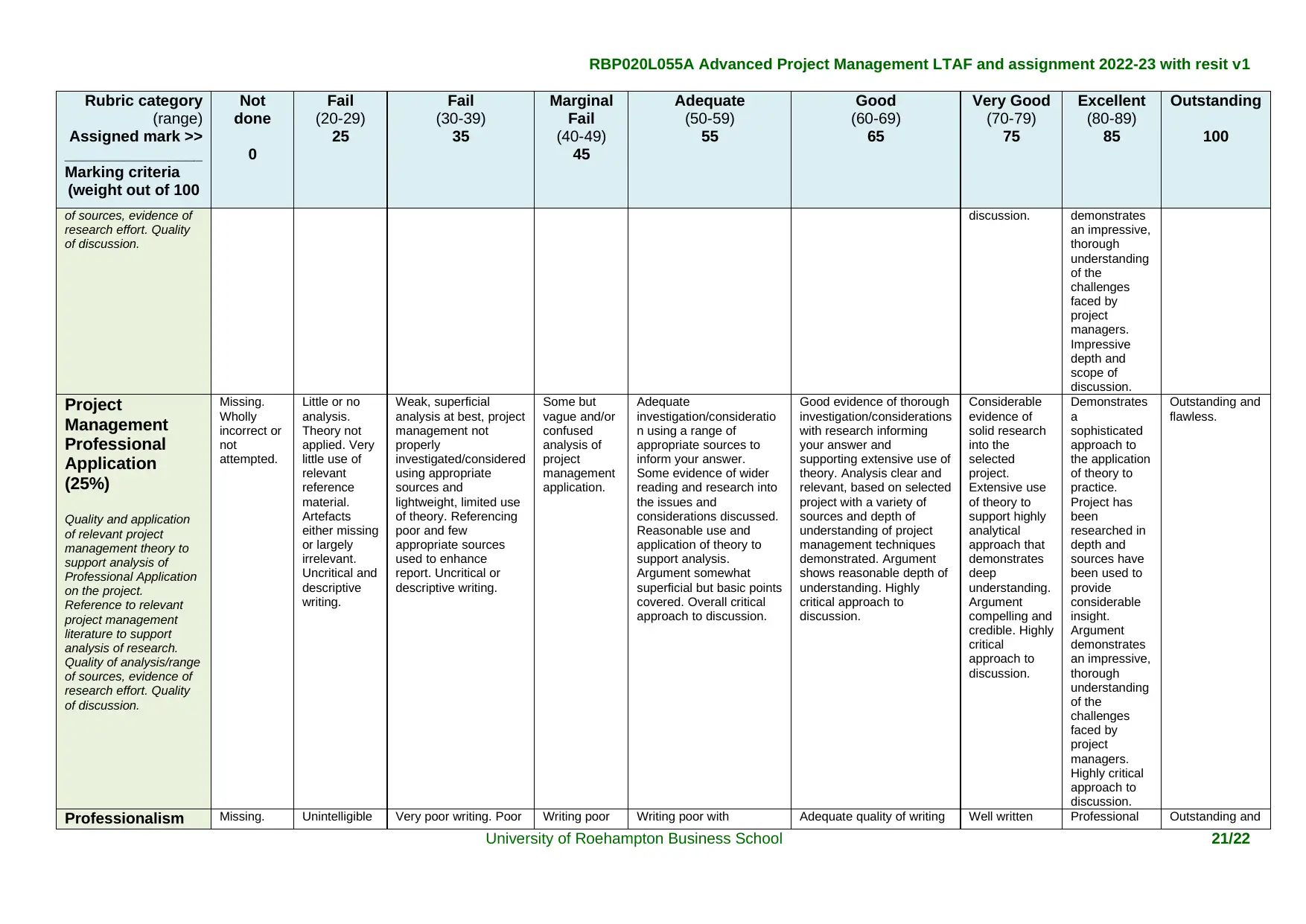
RBP020L055A Advanced Project Management LTAF and assignment 2022-23 with resit v1
Rubric category
(range)
Assigned mark >>
________________
Marking criteria
(weight out of 100
Not
done
0
Fail
(20-29)
25
Fail
(30-39)
35
Marginal
Fail
(40-49)
45
Adequate
(50-59)
55
Good
(60-69)
65
Very Good
(70-79)
75
Excellent
(80-89)
85
Outstanding
100
of sources, evidence of
research effort. Quality
of discussion.
discussion. demonstrates
an impressive,
thorough
understanding
of the
challenges
faced by
project
managers.
Impressive
depth and
scope of
discussion.
Project
Management
Professional
Application
(25%)
Quality and application
of relevant project
management theory to
support analysis of
Professional Application
on the project.
Reference to relevant
project management
literature to support
analysis of research.
Quality of analysis/range
of sources, evidence of
research effort. Quality
of discussion.
Missing.
Wholly
incorrect or
not
attempted.
Little or no
analysis.
Theory not
applied. Very
little use of
relevant
reference
material.
Artefacts
either missing
or largely
irrelevant.
Uncritical and
descriptive
writing.
Weak, superficial
analysis at best, project
management not
properly
investigated/considered
using appropriate
sources and
lightweight, limited use
of theory. Referencing
poor and few
appropriate sources
used to enhance
report. Uncritical or
descriptive writing.
Some but
vague and/or
confused
analysis of
project
management
application.
Adequate
investigation/consideratio
n using a range of
appropriate sources to
inform your answer.
Some evidence of wider
reading and research into
the issues and
considerations discussed.
Reasonable use and
application of theory to
support analysis.
Argument somewhat
superficial but basic points
covered. Overall critical
approach to discussion.
Good evidence of thorough
investigation/considerations
with research informing
your answer and
supporting extensive use of
theory. Analysis clear and
relevant, based on selected
project with a variety of
sources and depth of
understanding of project
management techniques
demonstrated. Argument
shows reasonable depth of
understanding. Highly
critical approach to
discussion.
Considerable
evidence of
solid research
into the
selected
project.
Extensive use
of theory to
support highly
analytical
approach that
demonstrates
deep
understanding.
Argument
compelling and
credible. Highly
critical
approach to
discussion.
Demonstrates
a
sophisticated
approach to
the application
of theory to
practice.
Project has
been
researched in
depth and
sources have
been used to
provide
considerable
insight.
Argument
demonstrates
an impressive,
thorough
understanding
of the
challenges
faced by
project
managers.
Highly critical
approach to
discussion.
Outstanding and
flawless.
Professionalism Missing. Unintelligible Very poor writing. Poor Writing poor Writing poor with Adequate quality of writing Well written Professional Outstanding and
University of Roehampton Business School 21/22
Rubric category
(range)
Assigned mark >>
________________
Marking criteria
(weight out of 100
Not
done
0
Fail
(20-29)
25
Fail
(30-39)
35
Marginal
Fail
(40-49)
45
Adequate
(50-59)
55
Good
(60-69)
65
Very Good
(70-79)
75
Excellent
(80-89)
85
Outstanding
100
of sources, evidence of
research effort. Quality
of discussion.
discussion. demonstrates
an impressive,
thorough
understanding
of the
challenges
faced by
project
managers.
Impressive
depth and
scope of
discussion.
Project
Management
Professional
Application
(25%)
Quality and application
of relevant project
management theory to
support analysis of
Professional Application
on the project.
Reference to relevant
project management
literature to support
analysis of research.
Quality of analysis/range
of sources, evidence of
research effort. Quality
of discussion.
Missing.
Wholly
incorrect or
not
attempted.
Little or no
analysis.
Theory not
applied. Very
little use of
relevant
reference
material.
Artefacts
either missing
or largely
irrelevant.
Uncritical and
descriptive
writing.
Weak, superficial
analysis at best, project
management not
properly
investigated/considered
using appropriate
sources and
lightweight, limited use
of theory. Referencing
poor and few
appropriate sources
used to enhance
report. Uncritical or
descriptive writing.
Some but
vague and/or
confused
analysis of
project
management
application.
Adequate
investigation/consideratio
n using a range of
appropriate sources to
inform your answer.
Some evidence of wider
reading and research into
the issues and
considerations discussed.
Reasonable use and
application of theory to
support analysis.
Argument somewhat
superficial but basic points
covered. Overall critical
approach to discussion.
Good evidence of thorough
investigation/considerations
with research informing
your answer and
supporting extensive use of
theory. Analysis clear and
relevant, based on selected
project with a variety of
sources and depth of
understanding of project
management techniques
demonstrated. Argument
shows reasonable depth of
understanding. Highly
critical approach to
discussion.
Considerable
evidence of
solid research
into the
selected
project.
Extensive use
of theory to
support highly
analytical
approach that
demonstrates
deep
understanding.
Argument
compelling and
credible. Highly
critical
approach to
discussion.
Demonstrates
a
sophisticated
approach to
the application
of theory to
practice.
Project has
been
researched in
depth and
sources have
been used to
provide
considerable
insight.
Argument
demonstrates
an impressive,
thorough
understanding
of the
challenges
faced by
project
managers.
Highly critical
approach to
discussion.
Outstanding and
flawless.
Professionalism Missing. Unintelligible Very poor writing. Poor Writing poor Writing poor with Adequate quality of writing Well written Professional Outstanding and
University of Roehampton Business School 21/22
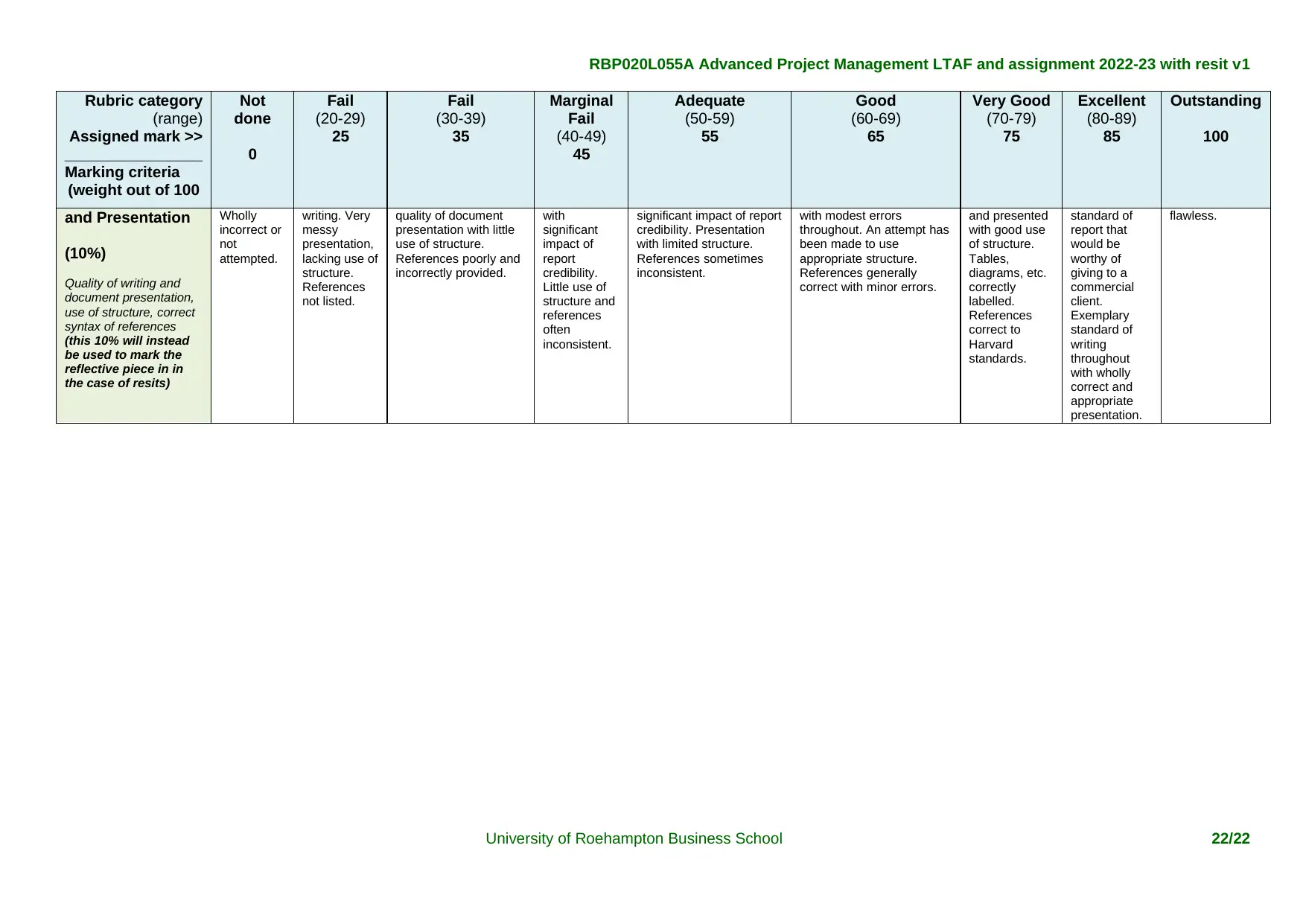
RBP020L055A Advanced Project Management LTAF and assignment 2022-23 with resit v1
Rubric category
(range)
Assigned mark >>
________________
Marking criteria
(weight out of 100
Not
done
0
Fail
(20-29)
25
Fail
(30-39)
35
Marginal
Fail
(40-49)
45
Adequate
(50-59)
55
Good
(60-69)
65
Very Good
(70-79)
75
Excellent
(80-89)
85
Outstanding
100
and Presentation
(10%)
Quality of writing and
document presentation,
use of structure, correct
syntax of references
(this 10% will instead
be used to mark the
reflective piece in in
the case of resits)
Wholly
incorrect or
not
attempted.
writing. Very
messy
presentation,
lacking use of
structure.
References
not listed.
quality of document
presentation with little
use of structure.
References poorly and
incorrectly provided.
with
significant
impact of
report
credibility.
Little use of
structure and
references
often
inconsistent.
significant impact of report
credibility. Presentation
with limited structure.
References sometimes
inconsistent.
with modest errors
throughout. An attempt has
been made to use
appropriate structure.
References generally
correct with minor errors.
and presented
with good use
of structure.
Tables,
diagrams, etc.
correctly
labelled.
References
correct to
Harvard
standards.
standard of
report that
would be
worthy of
giving to a
commercial
client.
Exemplary
standard of
writing
throughout
with wholly
correct and
appropriate
presentation.
flawless.
University of Roehampton Business School 22/22
Rubric category
(range)
Assigned mark >>
________________
Marking criteria
(weight out of 100
Not
done
0
Fail
(20-29)
25
Fail
(30-39)
35
Marginal
Fail
(40-49)
45
Adequate
(50-59)
55
Good
(60-69)
65
Very Good
(70-79)
75
Excellent
(80-89)
85
Outstanding
100
and Presentation
(10%)
Quality of writing and
document presentation,
use of structure, correct
syntax of references
(this 10% will instead
be used to mark the
reflective piece in in
the case of resits)
Wholly
incorrect or
not
attempted.
writing. Very
messy
presentation,
lacking use of
structure.
References
not listed.
quality of document
presentation with little
use of structure.
References poorly and
incorrectly provided.
with
significant
impact of
report
credibility.
Little use of
structure and
references
often
inconsistent.
significant impact of report
credibility. Presentation
with limited structure.
References sometimes
inconsistent.
with modest errors
throughout. An attempt has
been made to use
appropriate structure.
References generally
correct with minor errors.
and presented
with good use
of structure.
Tables,
diagrams, etc.
correctly
labelled.
References
correct to
Harvard
standards.
standard of
report that
would be
worthy of
giving to a
commercial
client.
Exemplary
standard of
writing
throughout
with wholly
correct and
appropriate
presentation.
flawless.
University of Roehampton Business School 22/22
1 out of 22
Related Documents
Your All-in-One AI-Powered Toolkit for Academic Success.
+13062052269
info@desklib.com
Available 24*7 on WhatsApp / Email
![[object Object]](/_next/static/media/star-bottom.7253800d.svg)
Unlock your academic potential
© 2024 | Zucol Services PVT LTD | All rights reserved.



